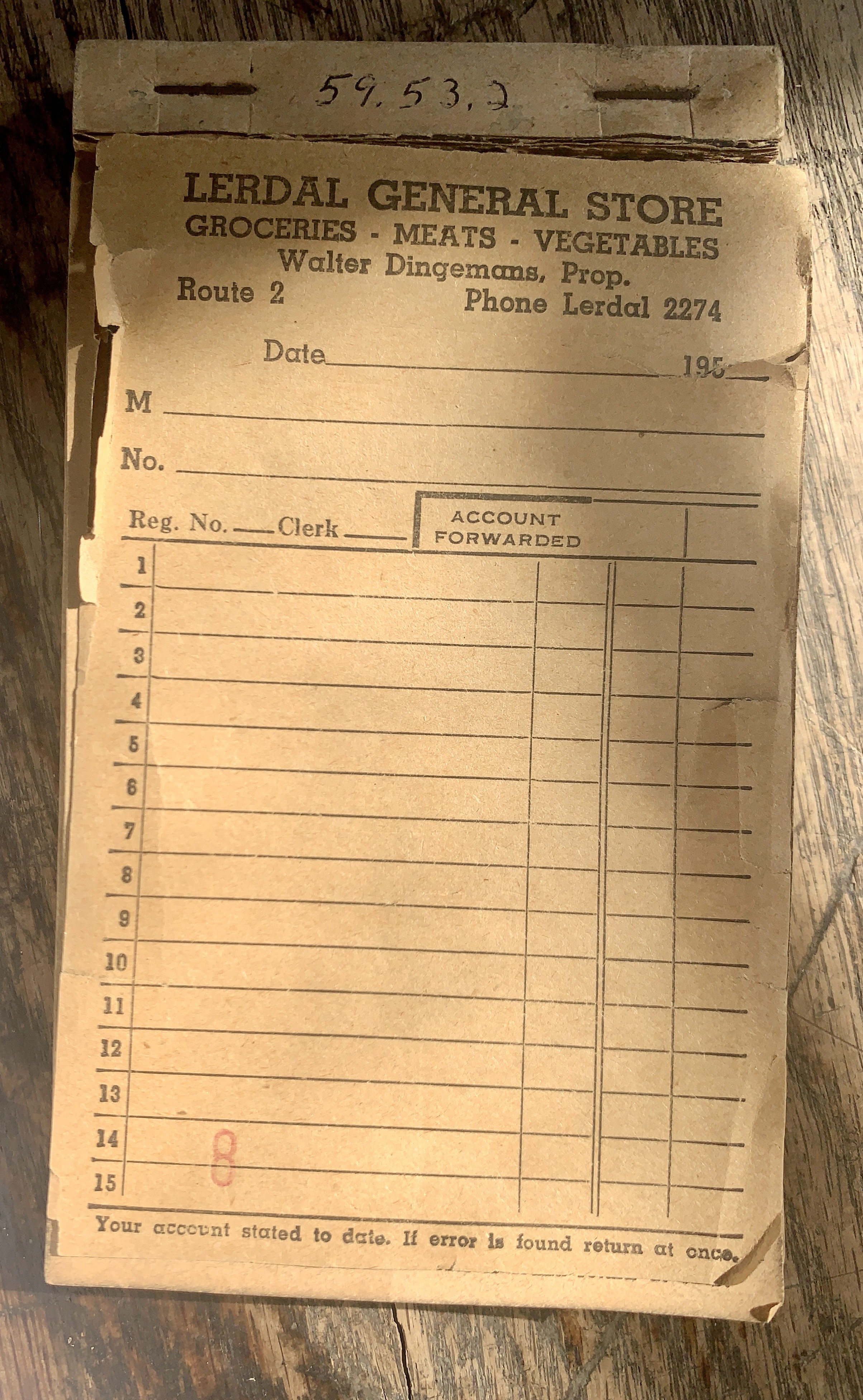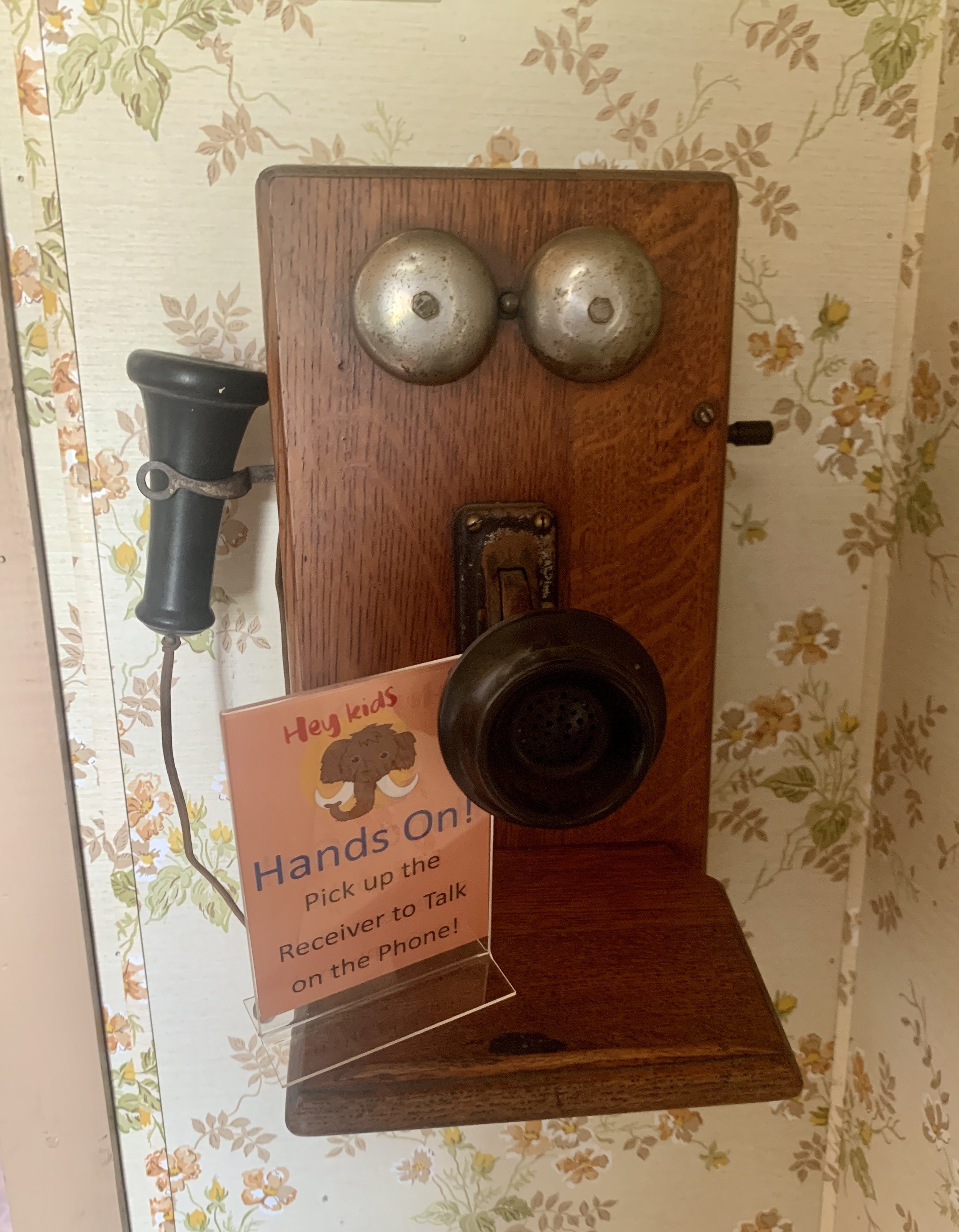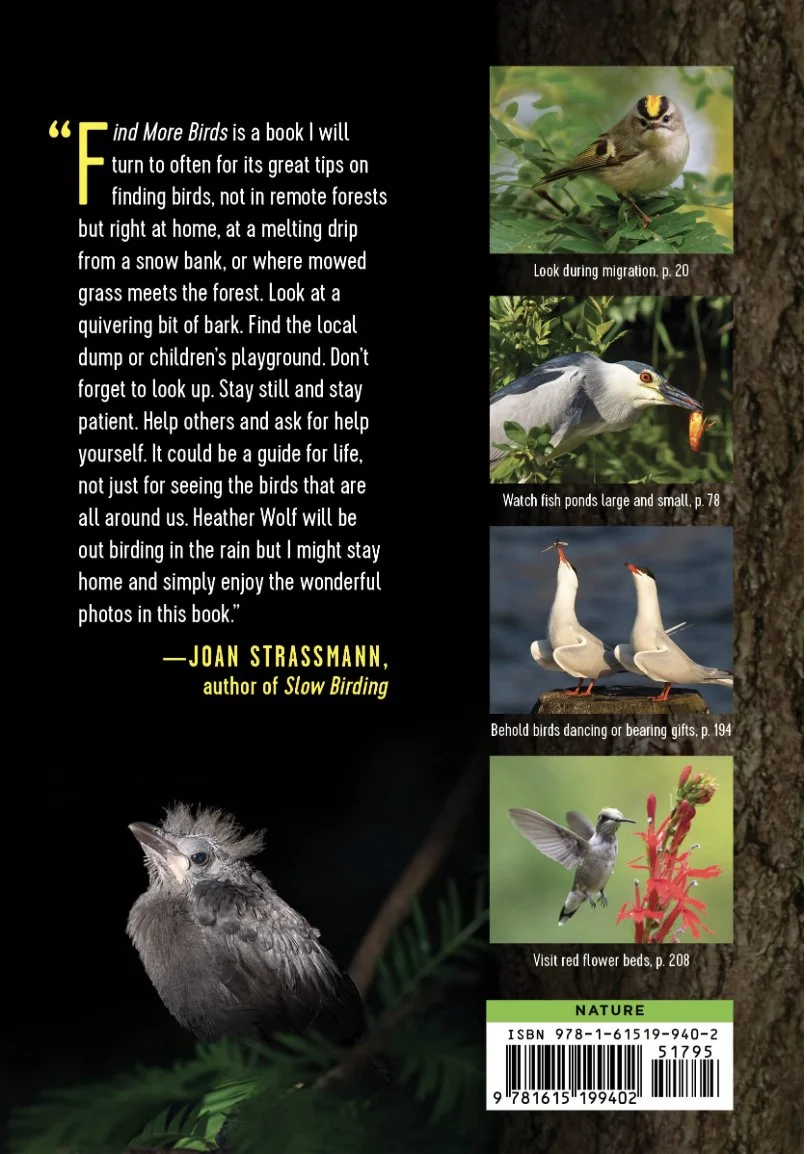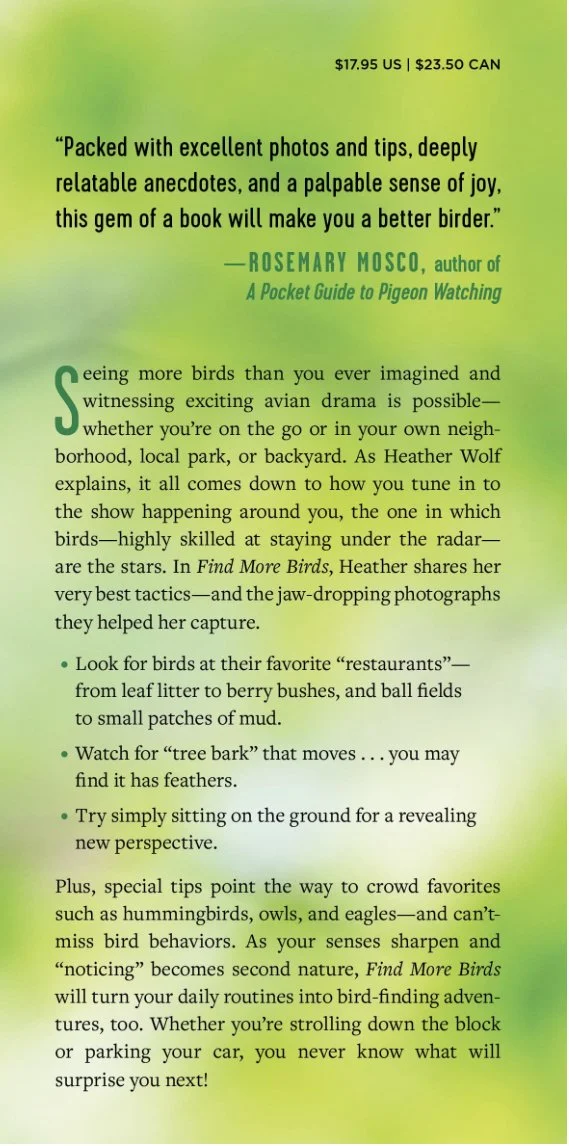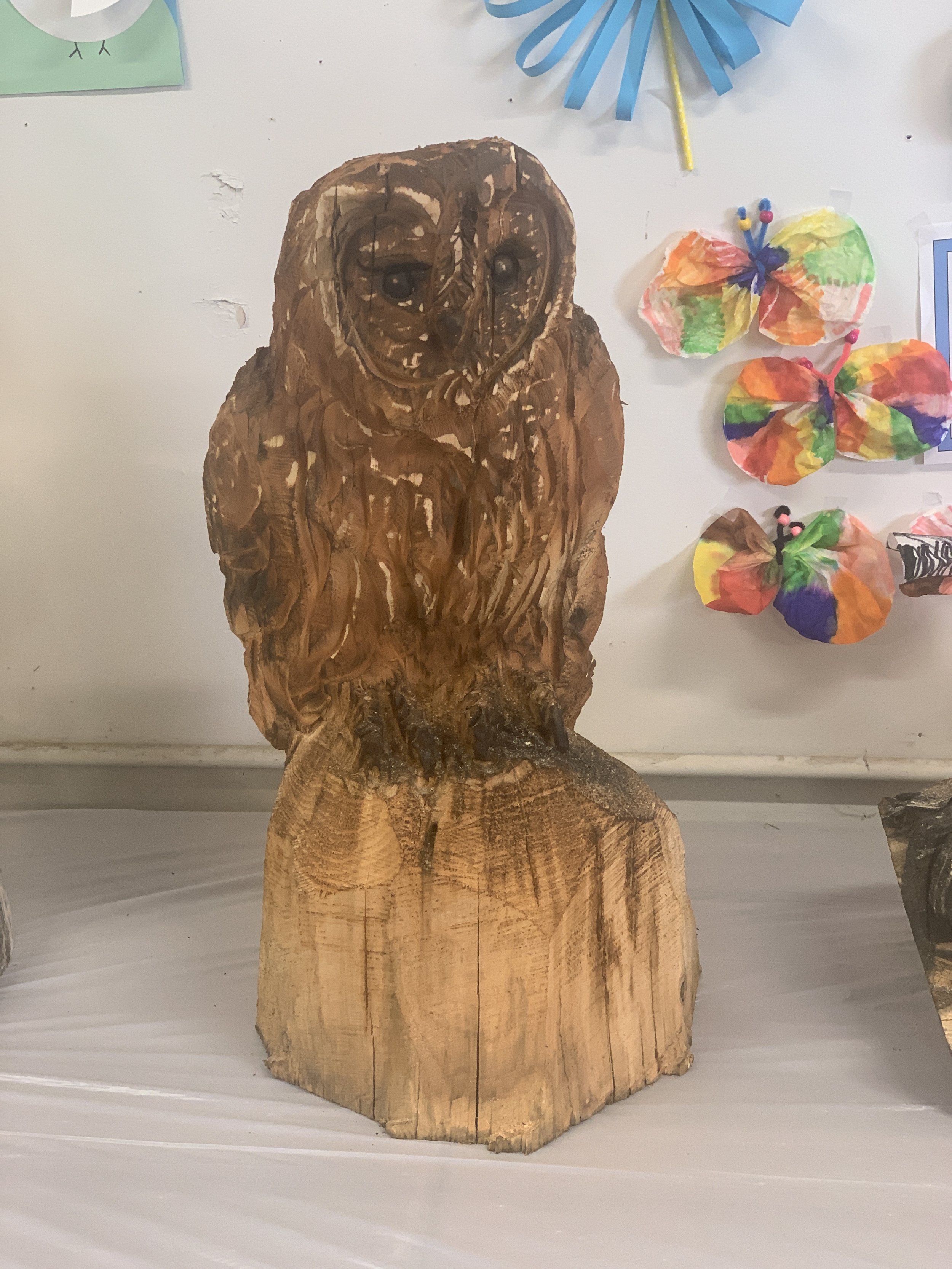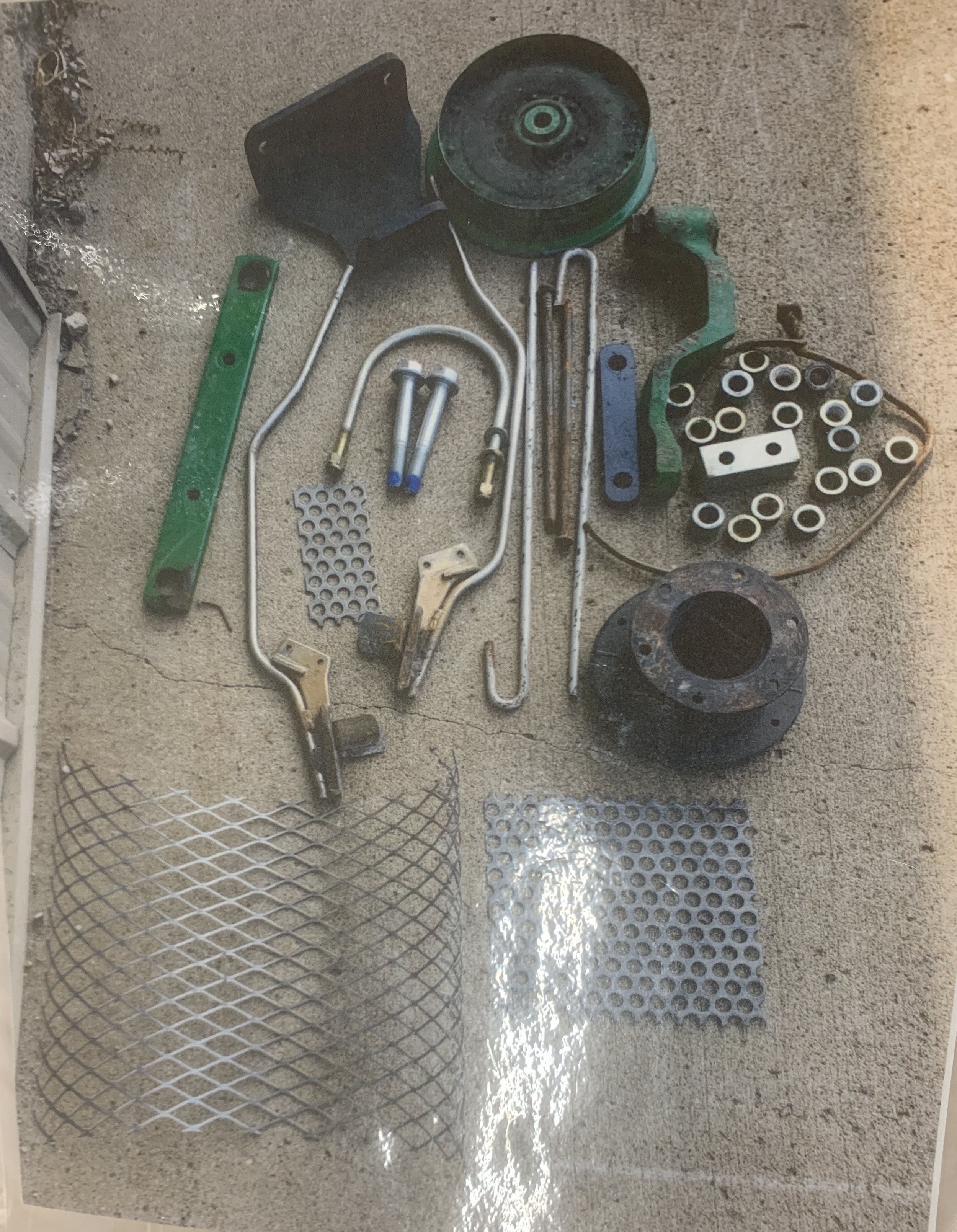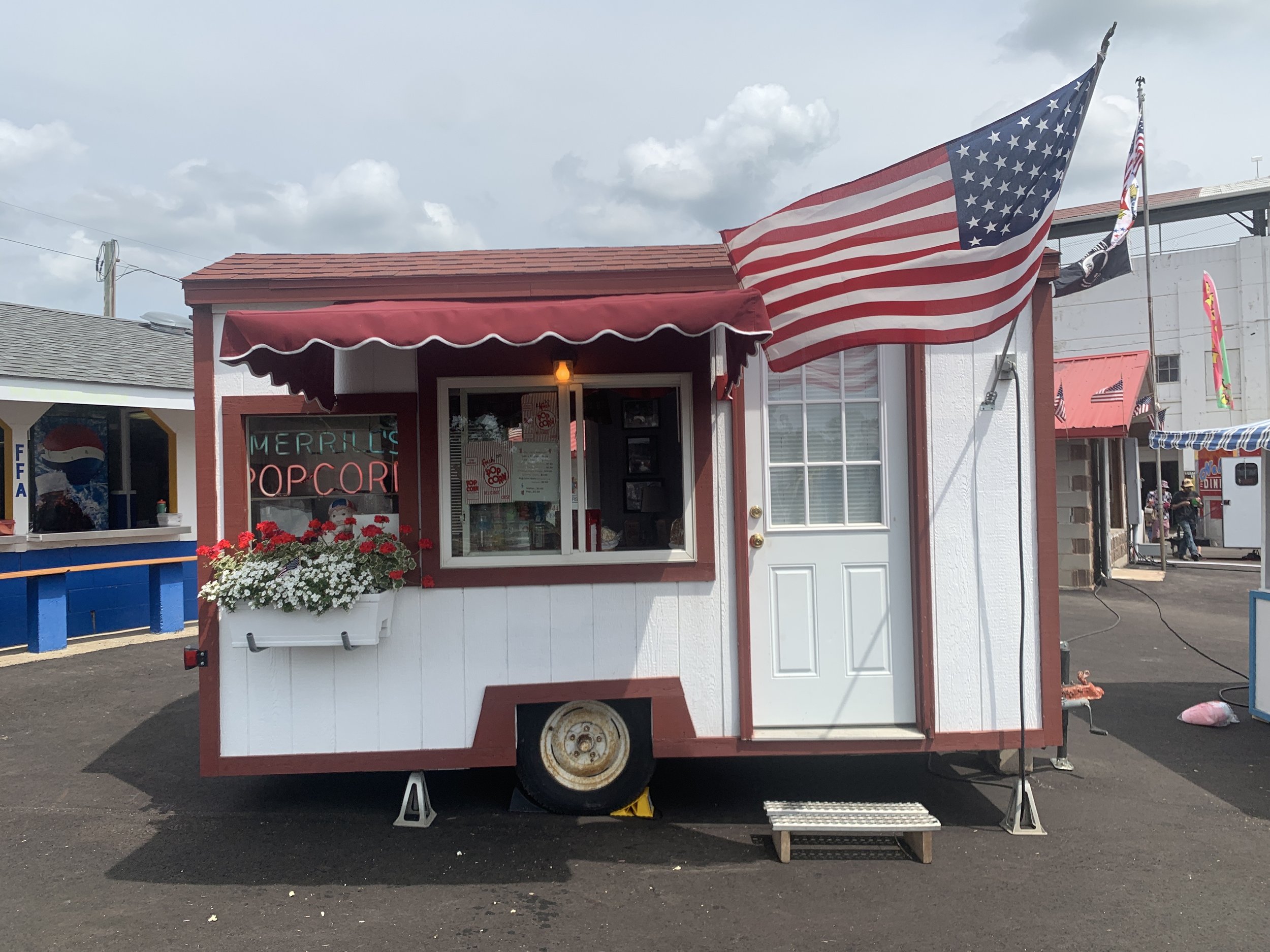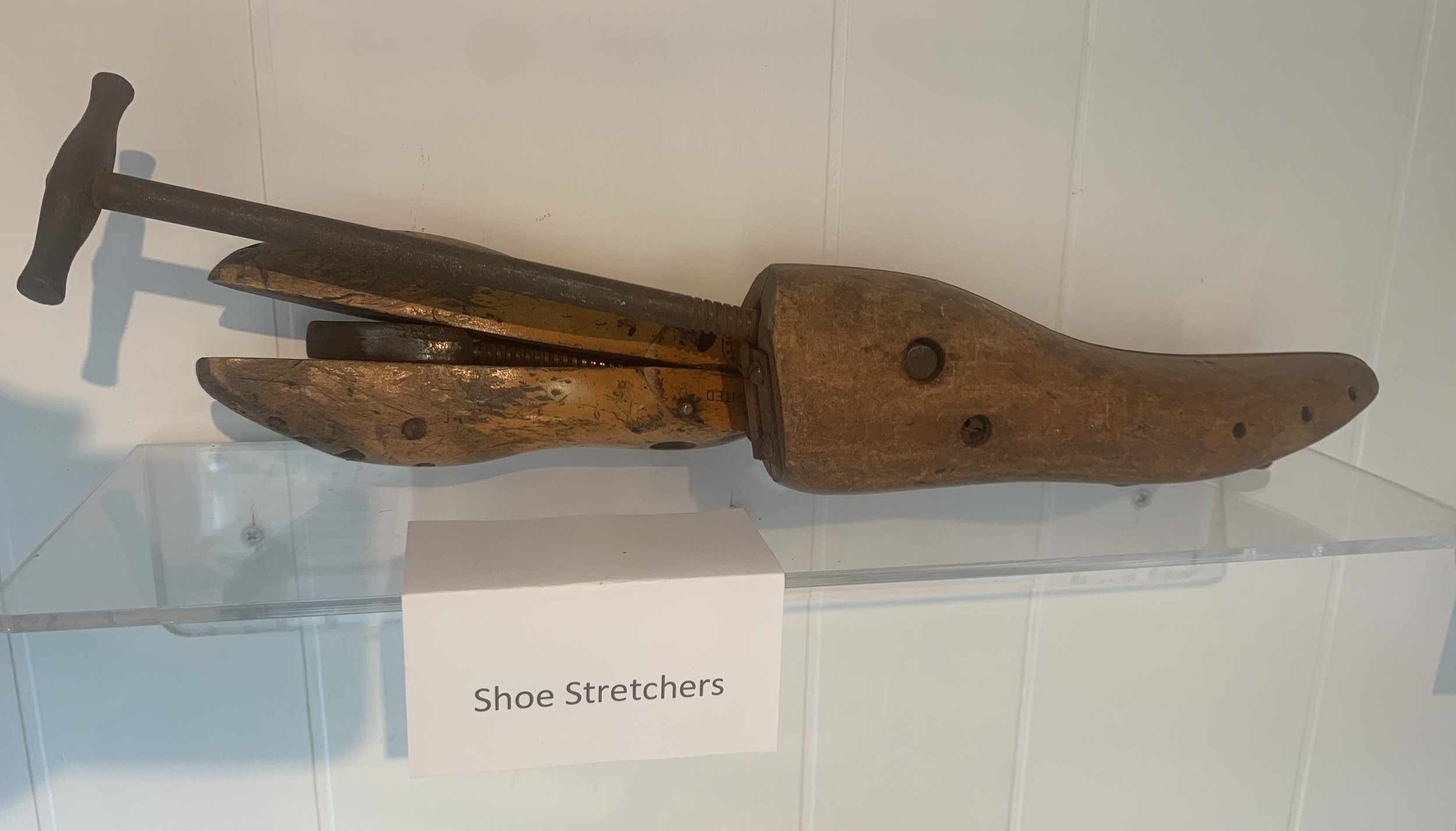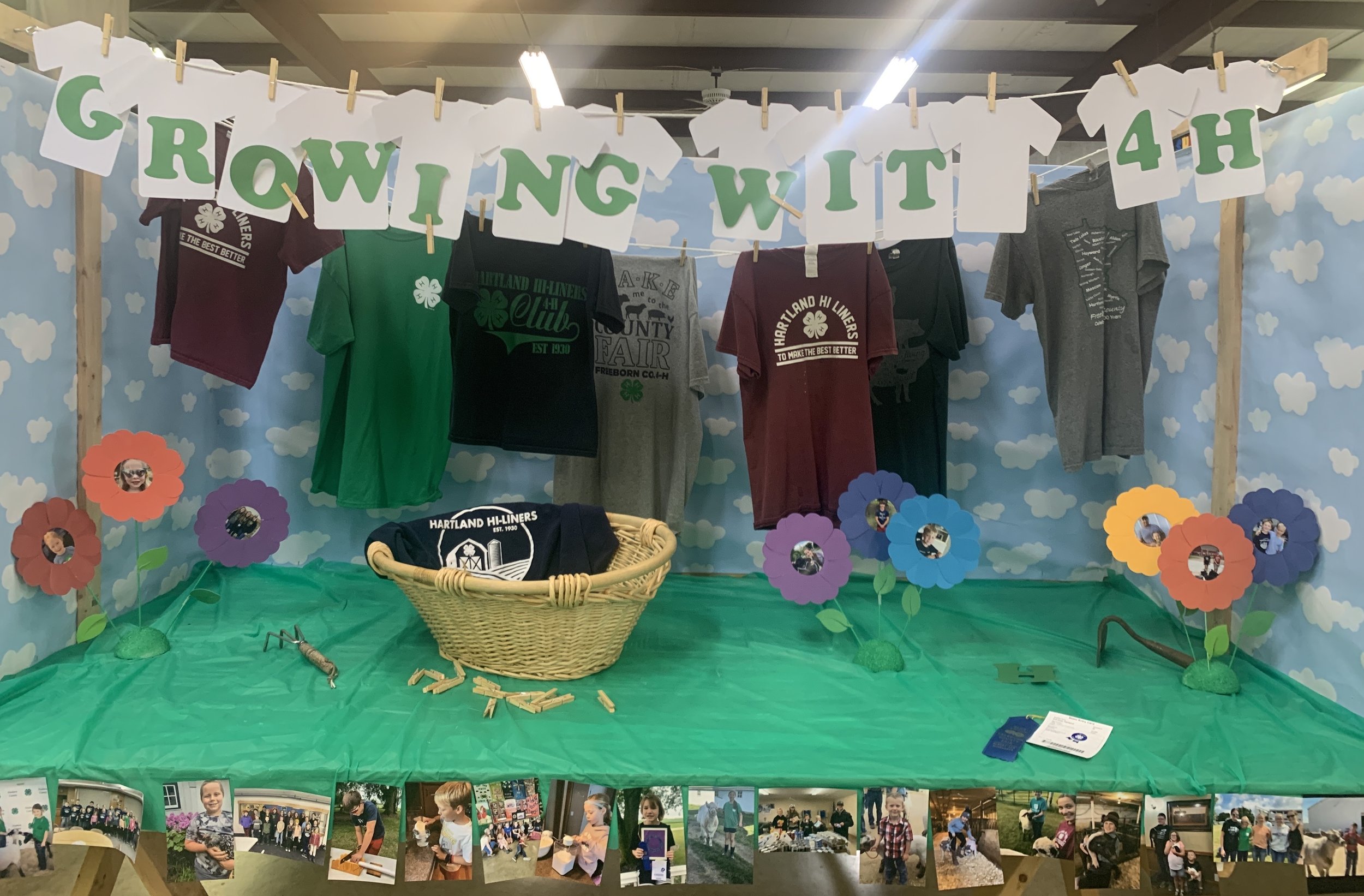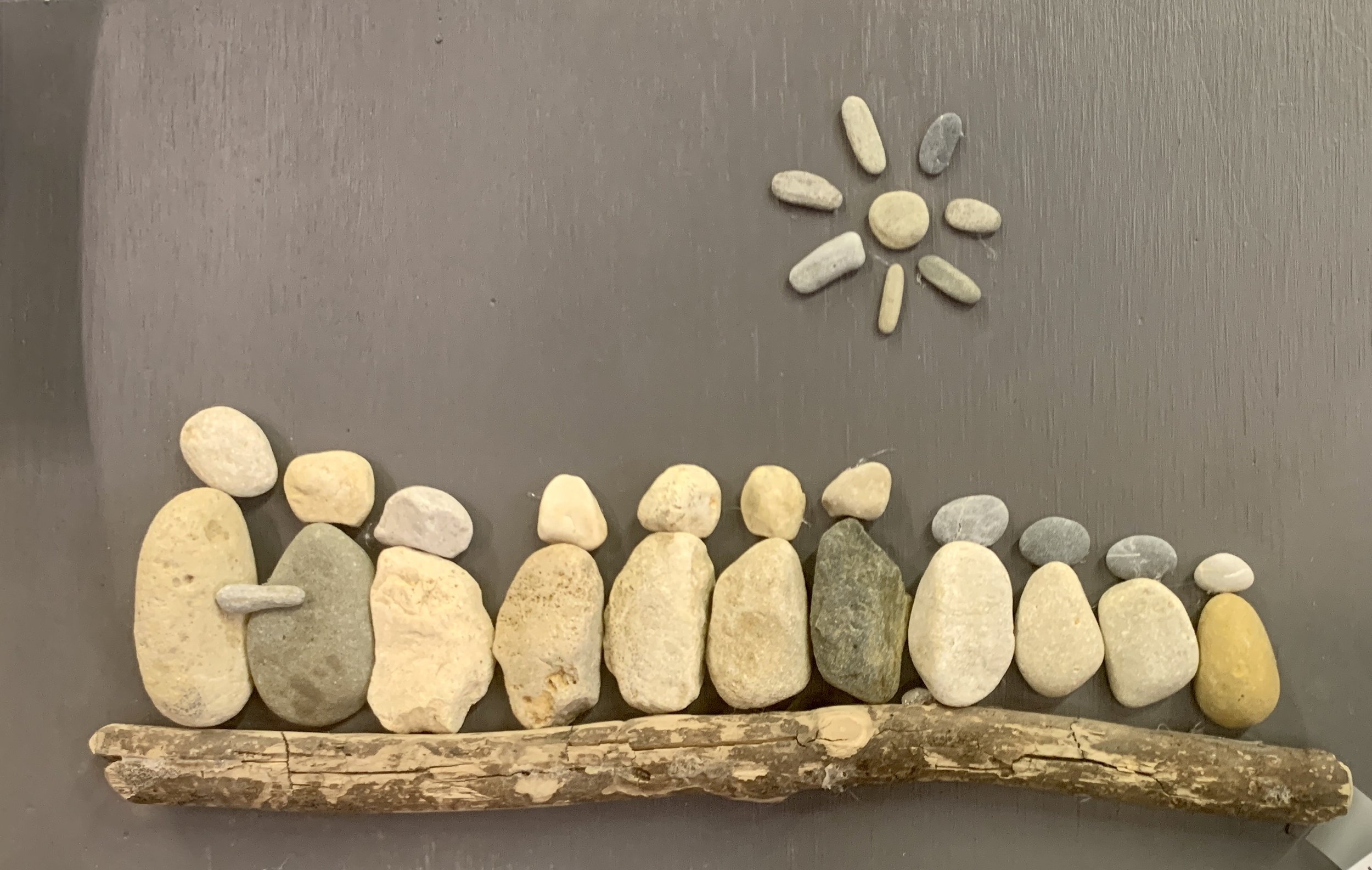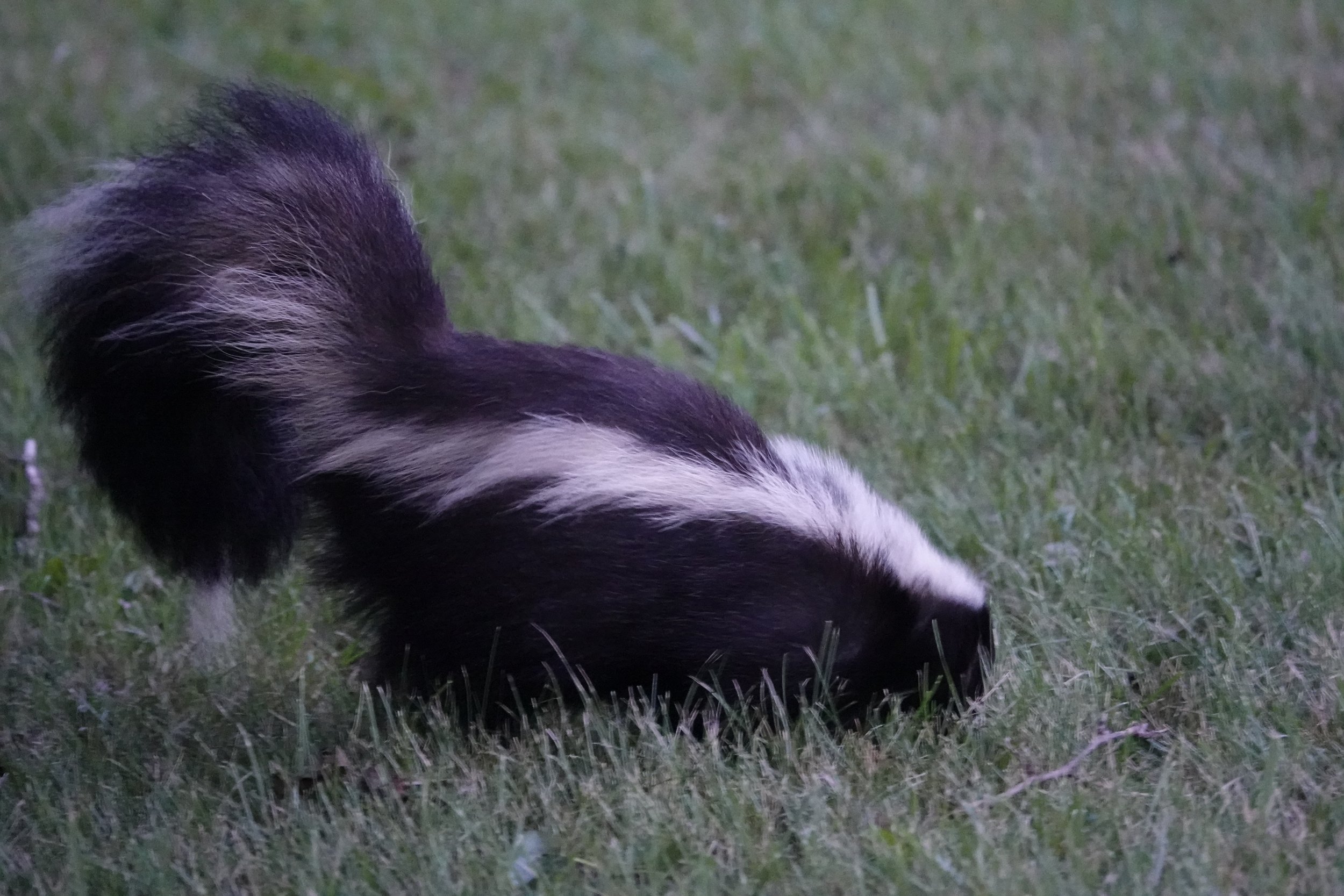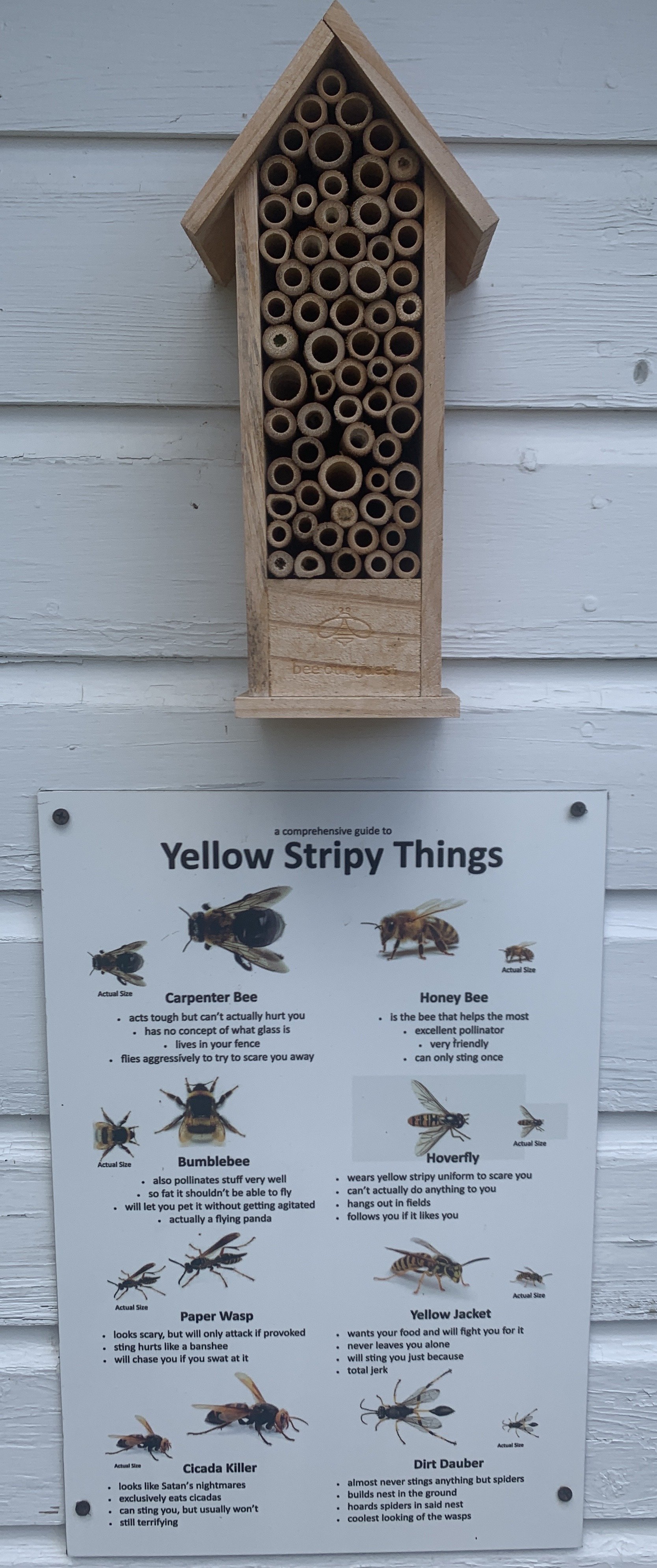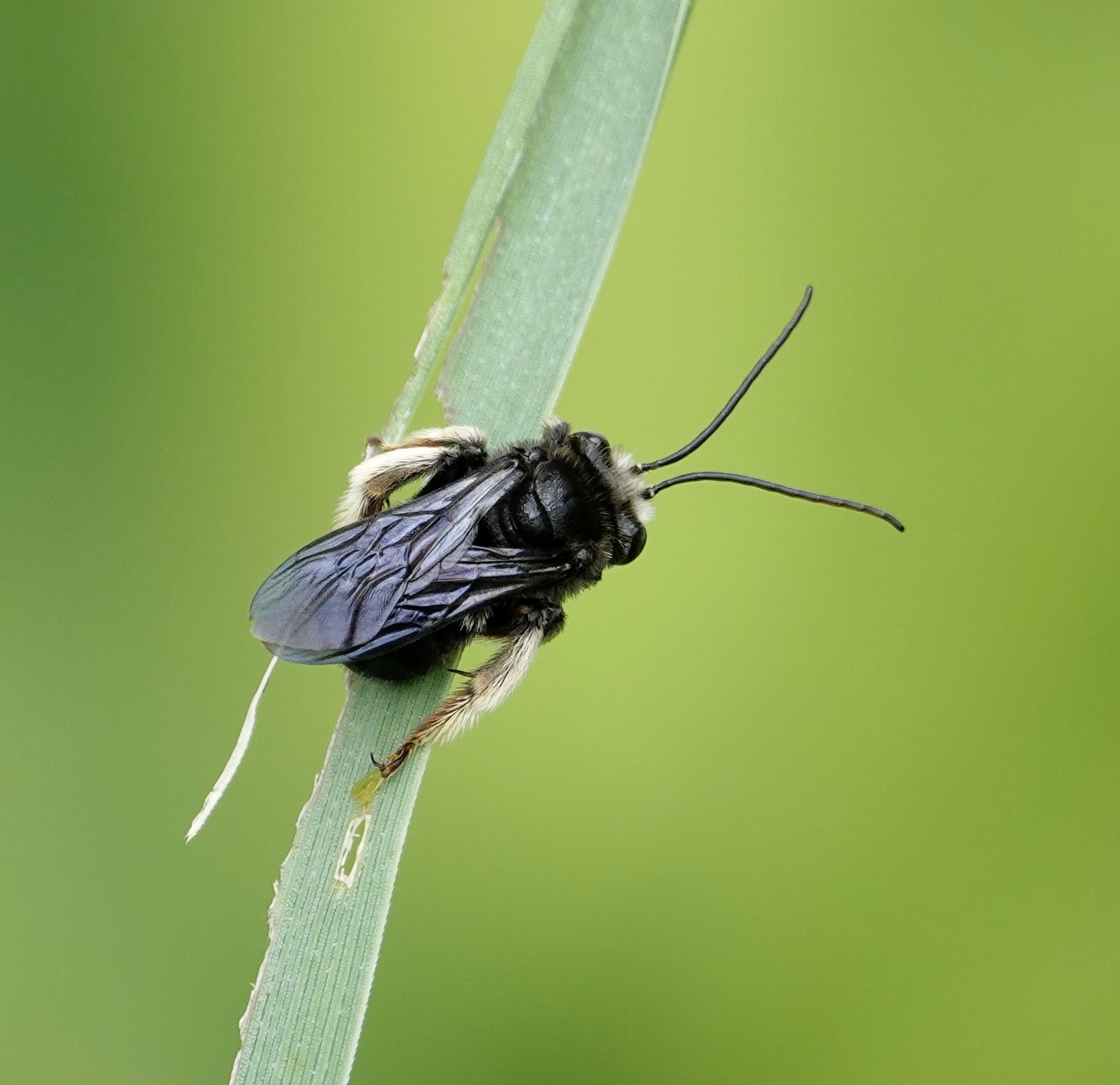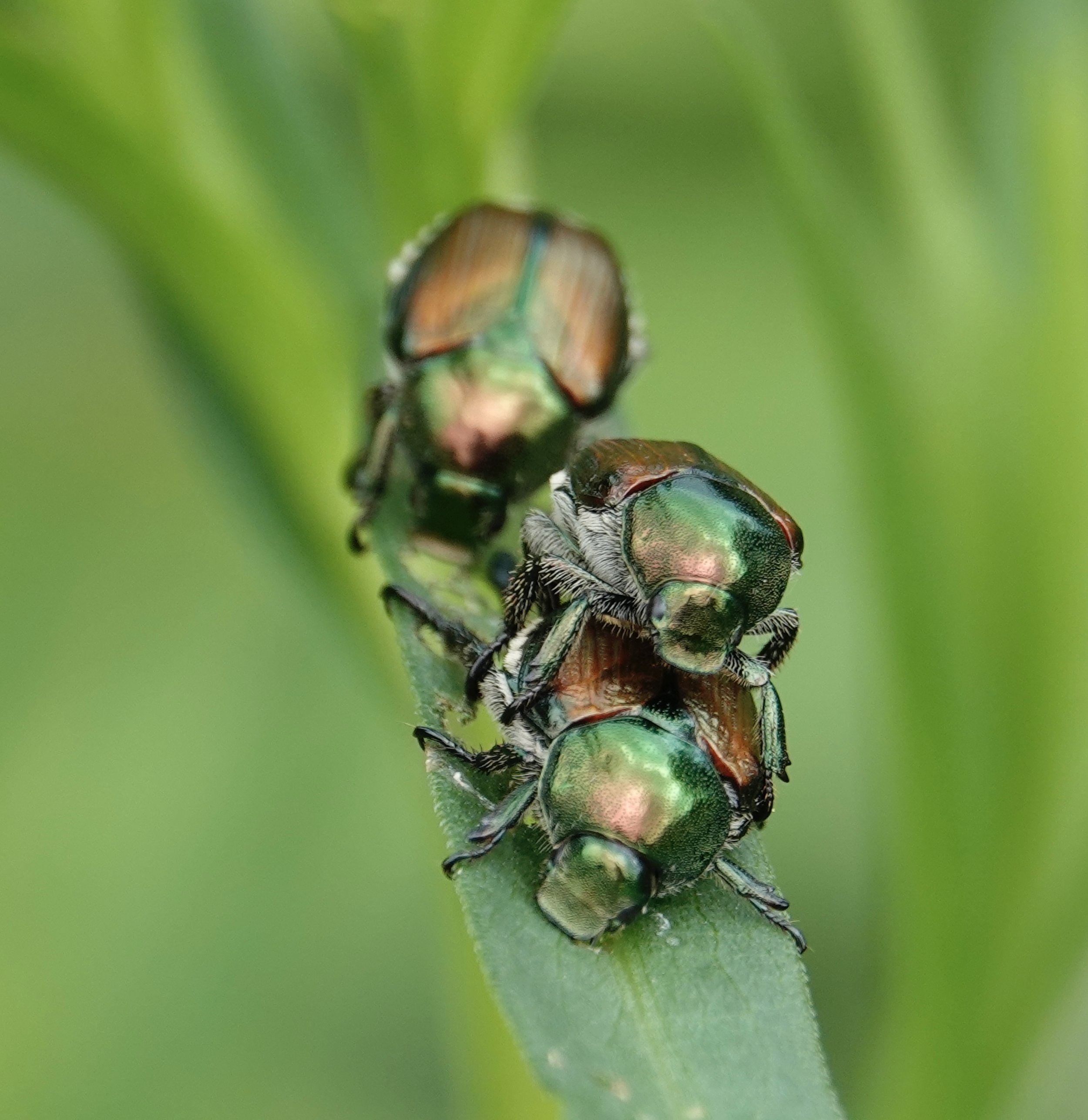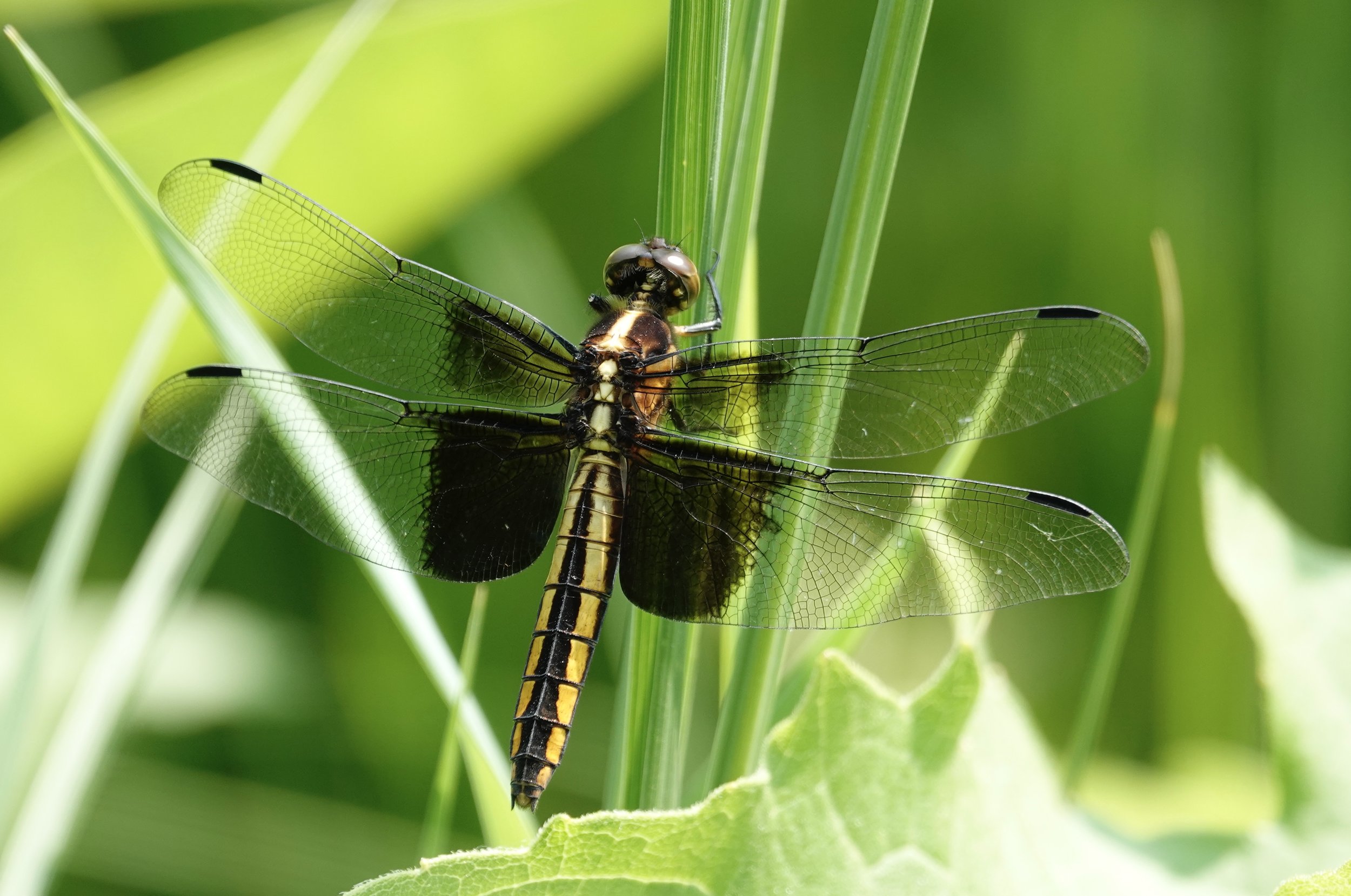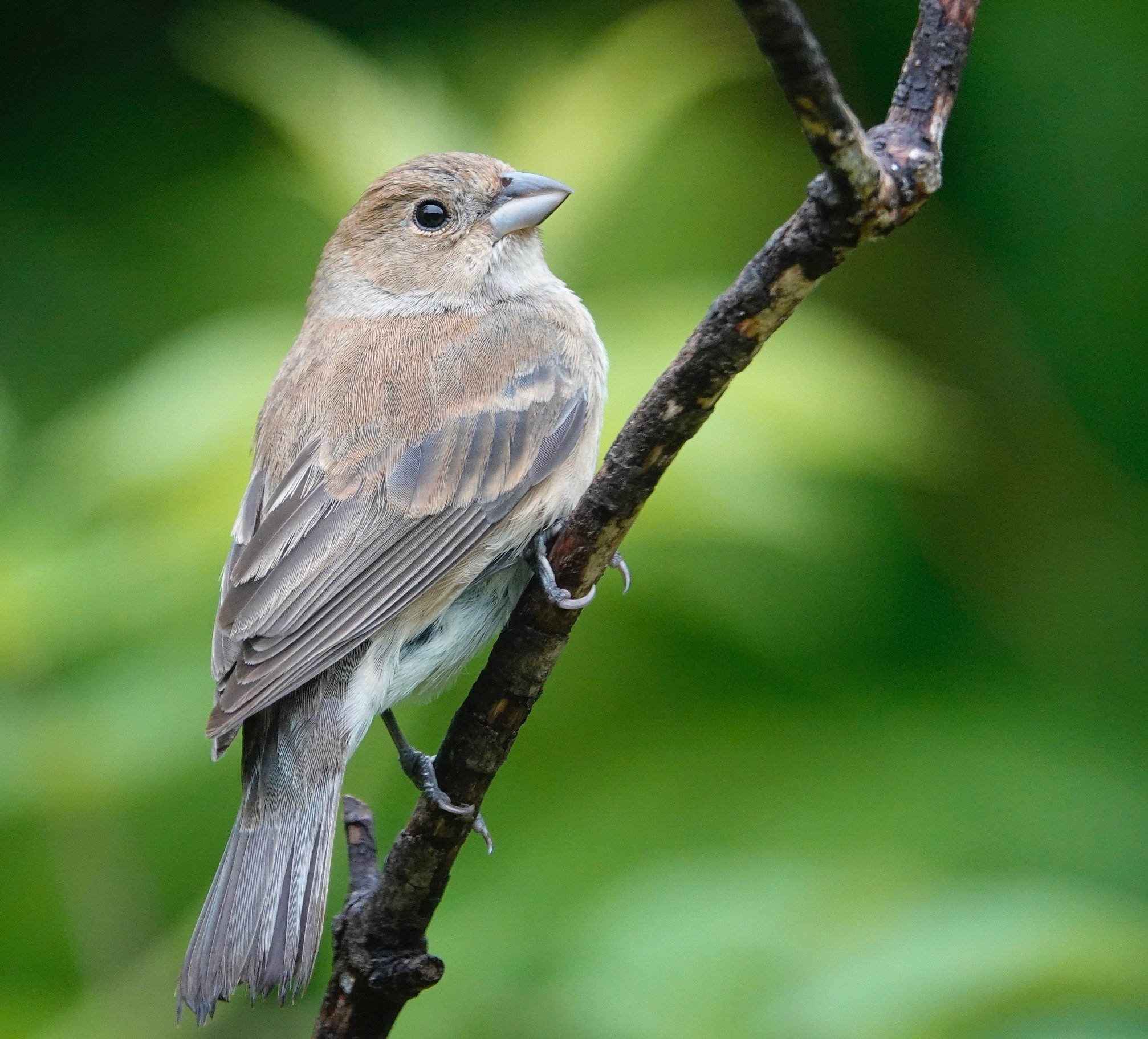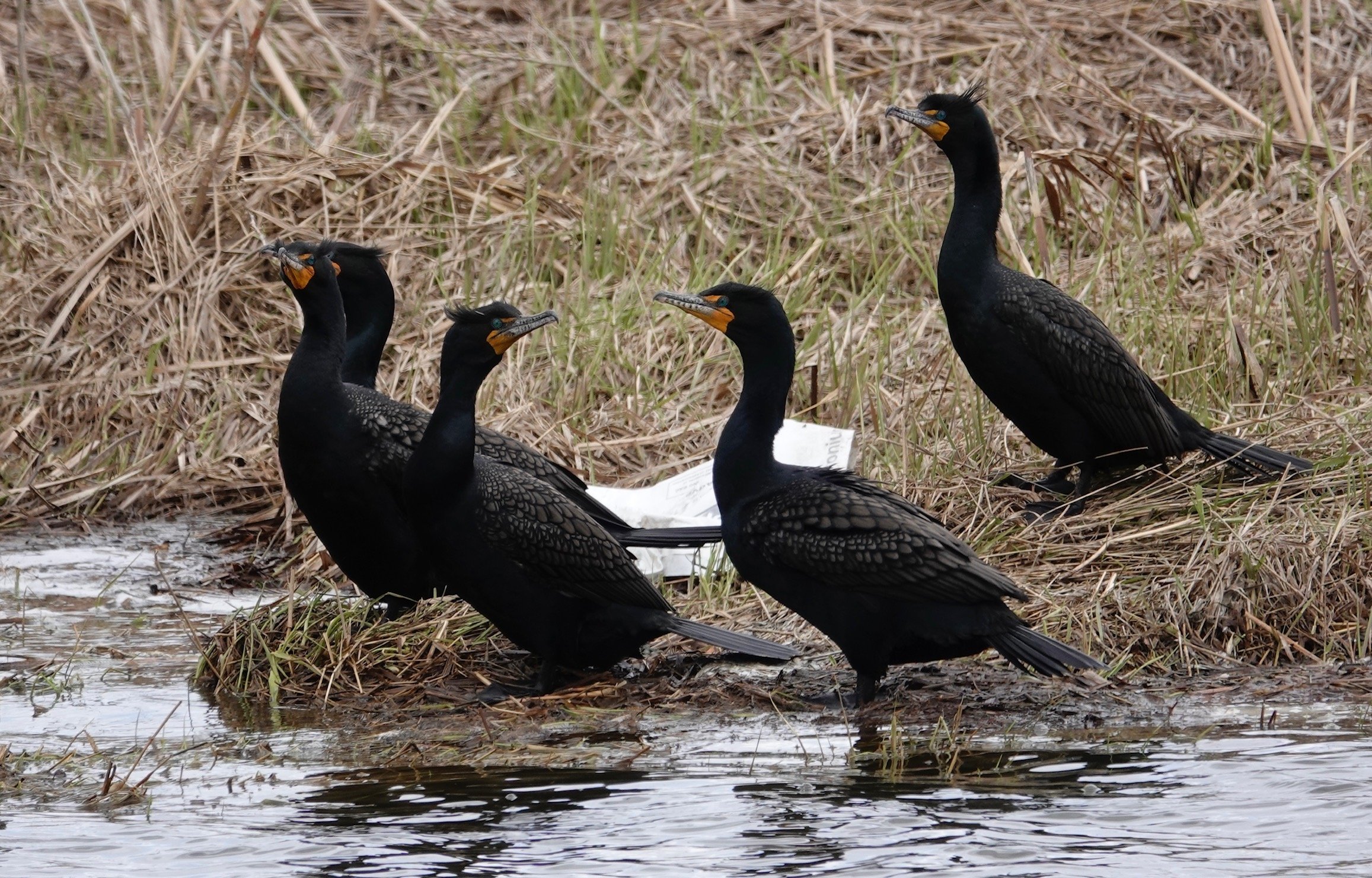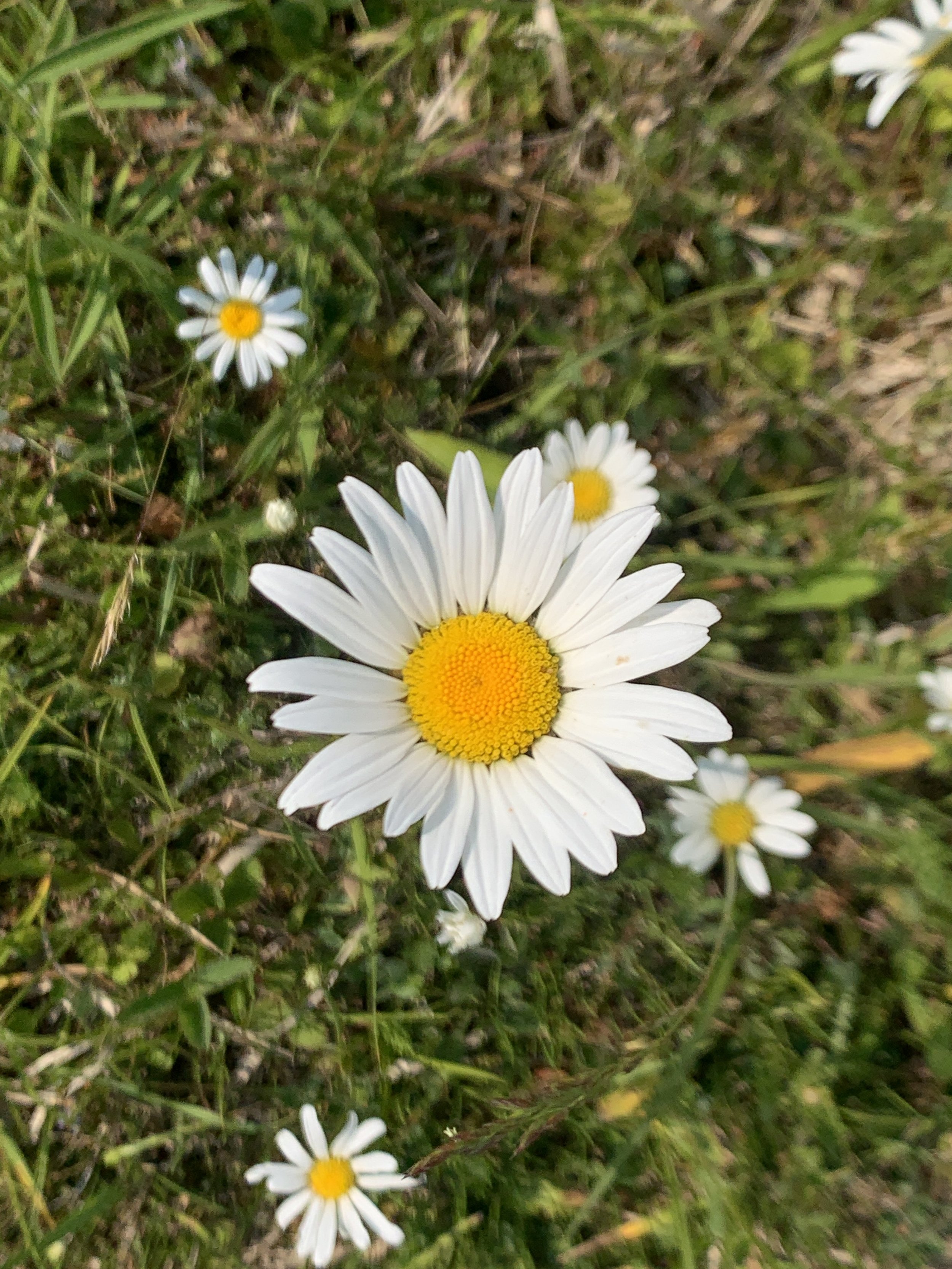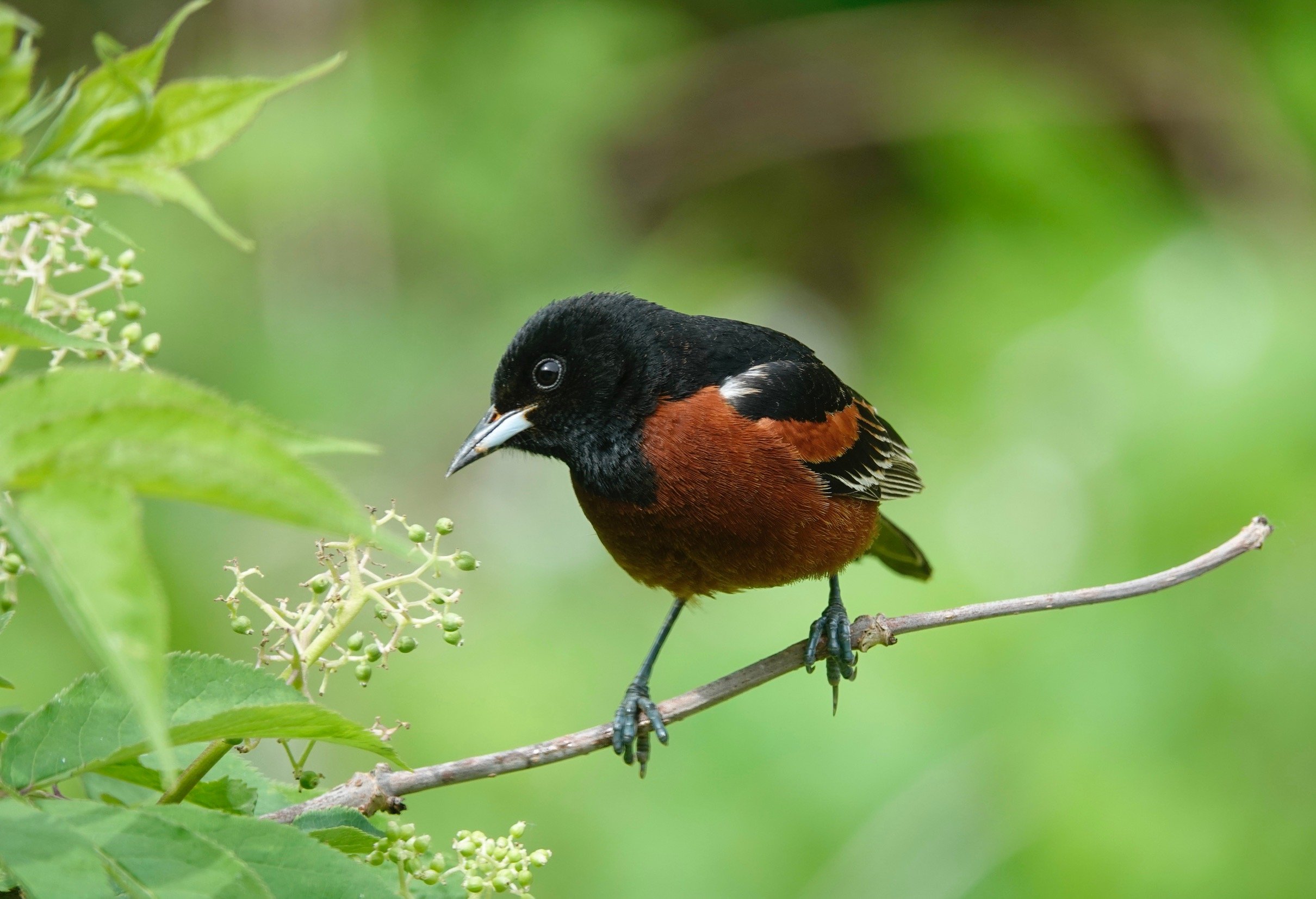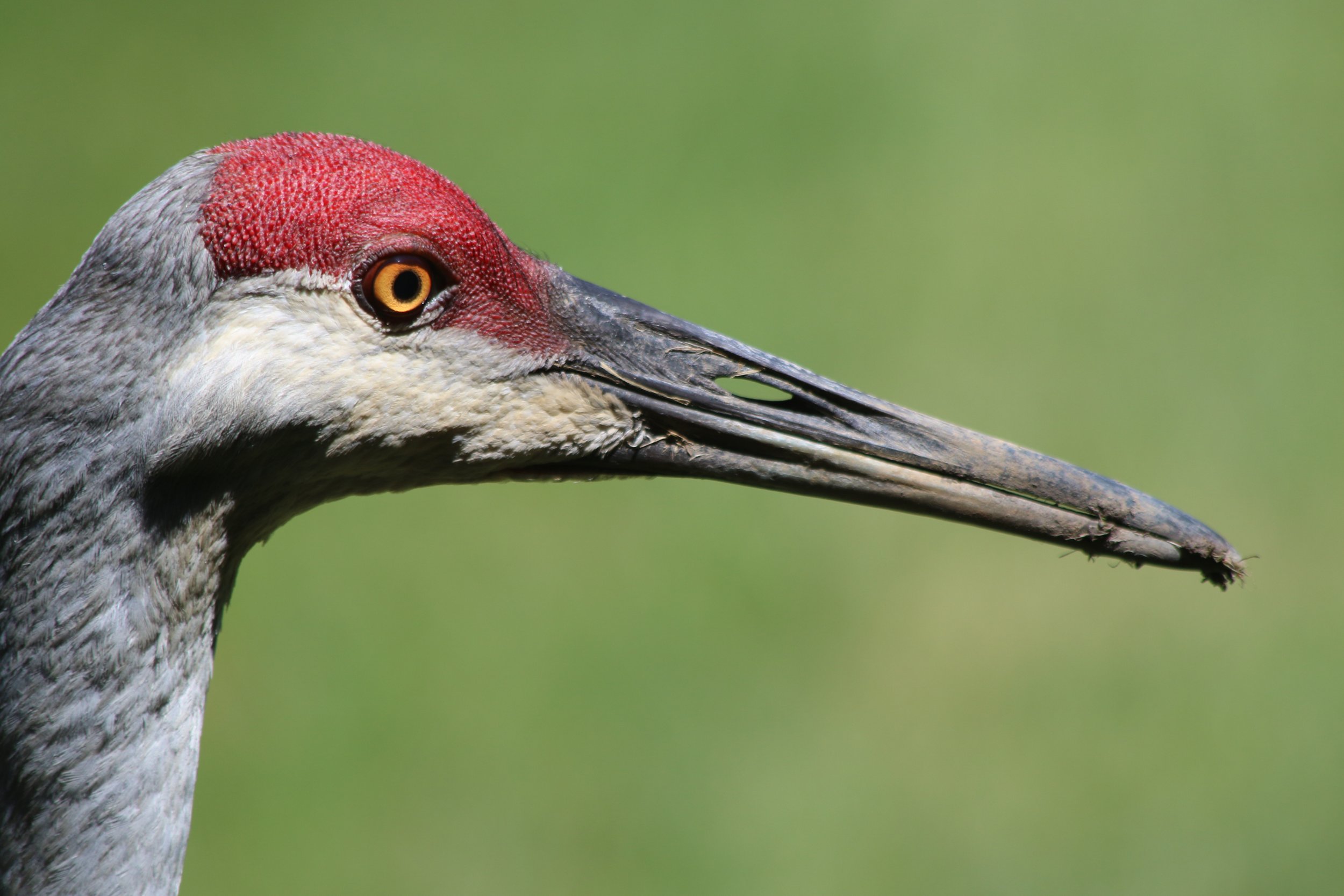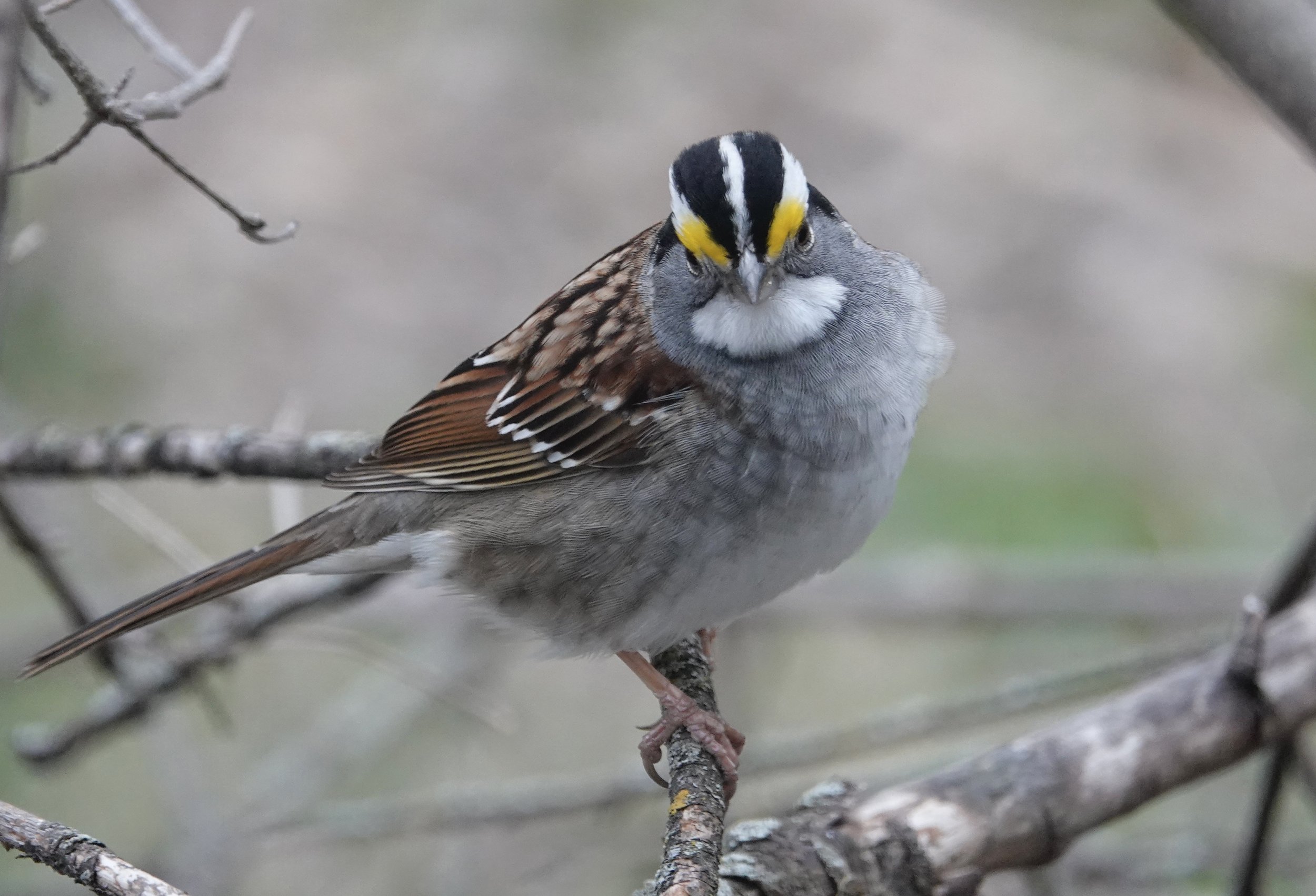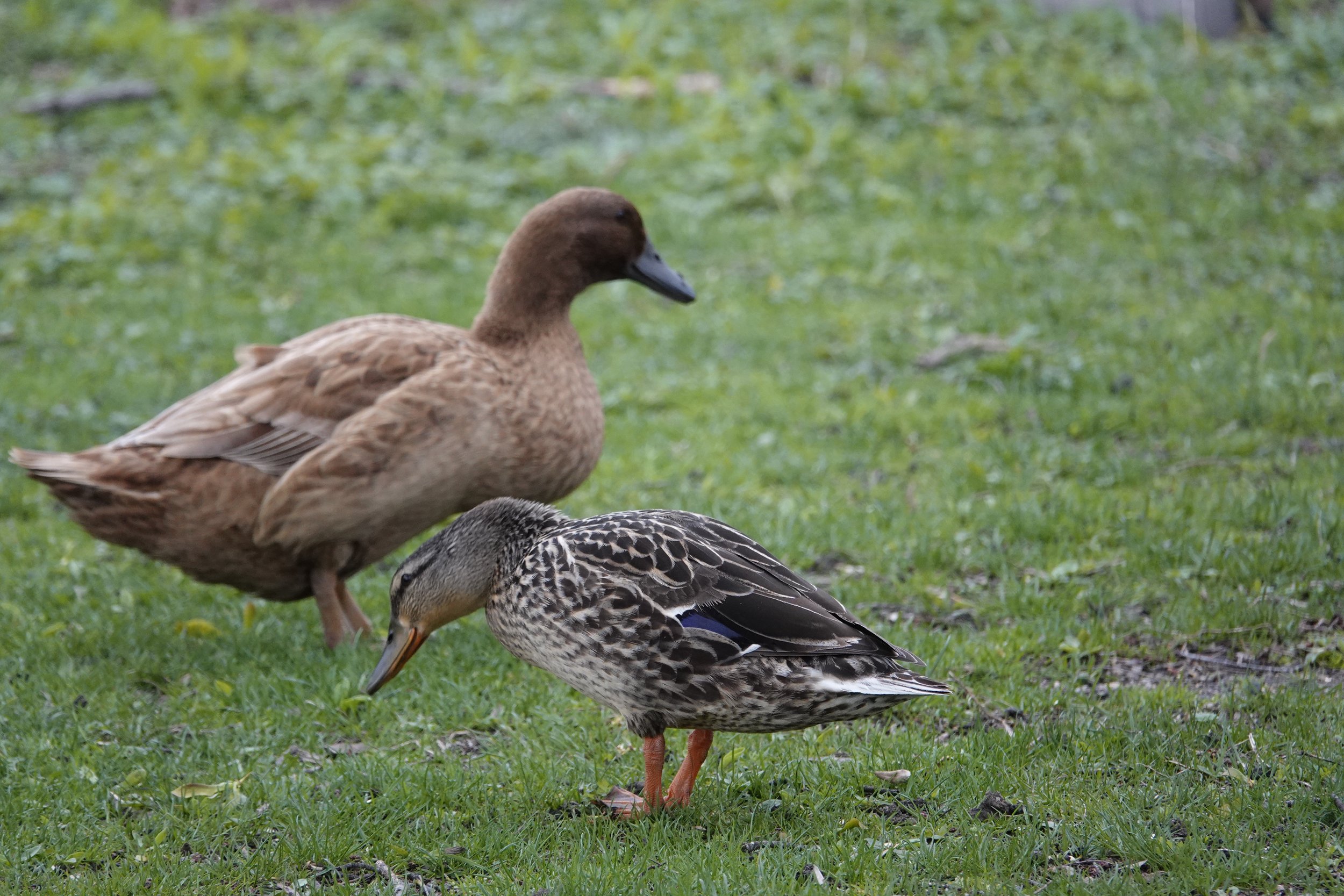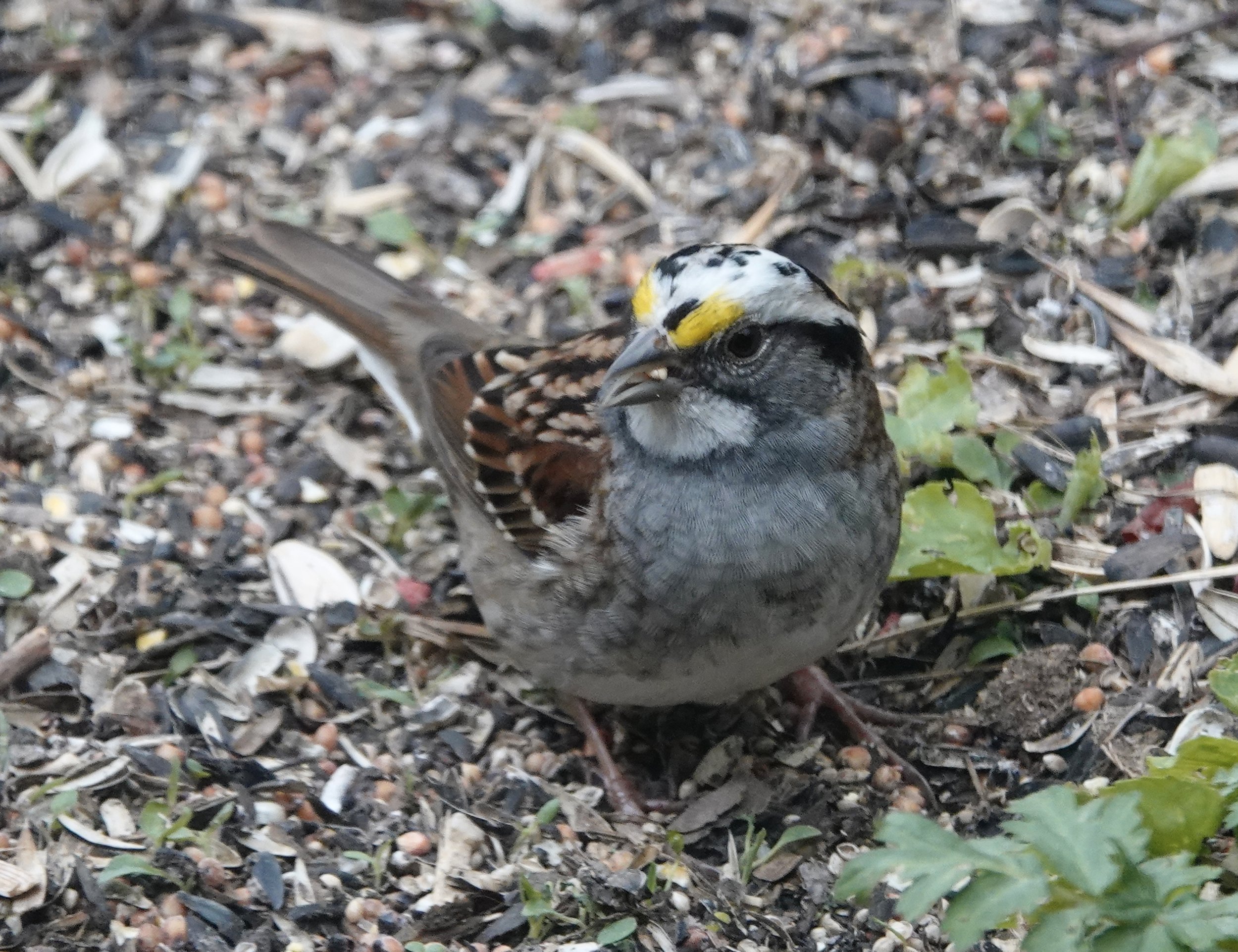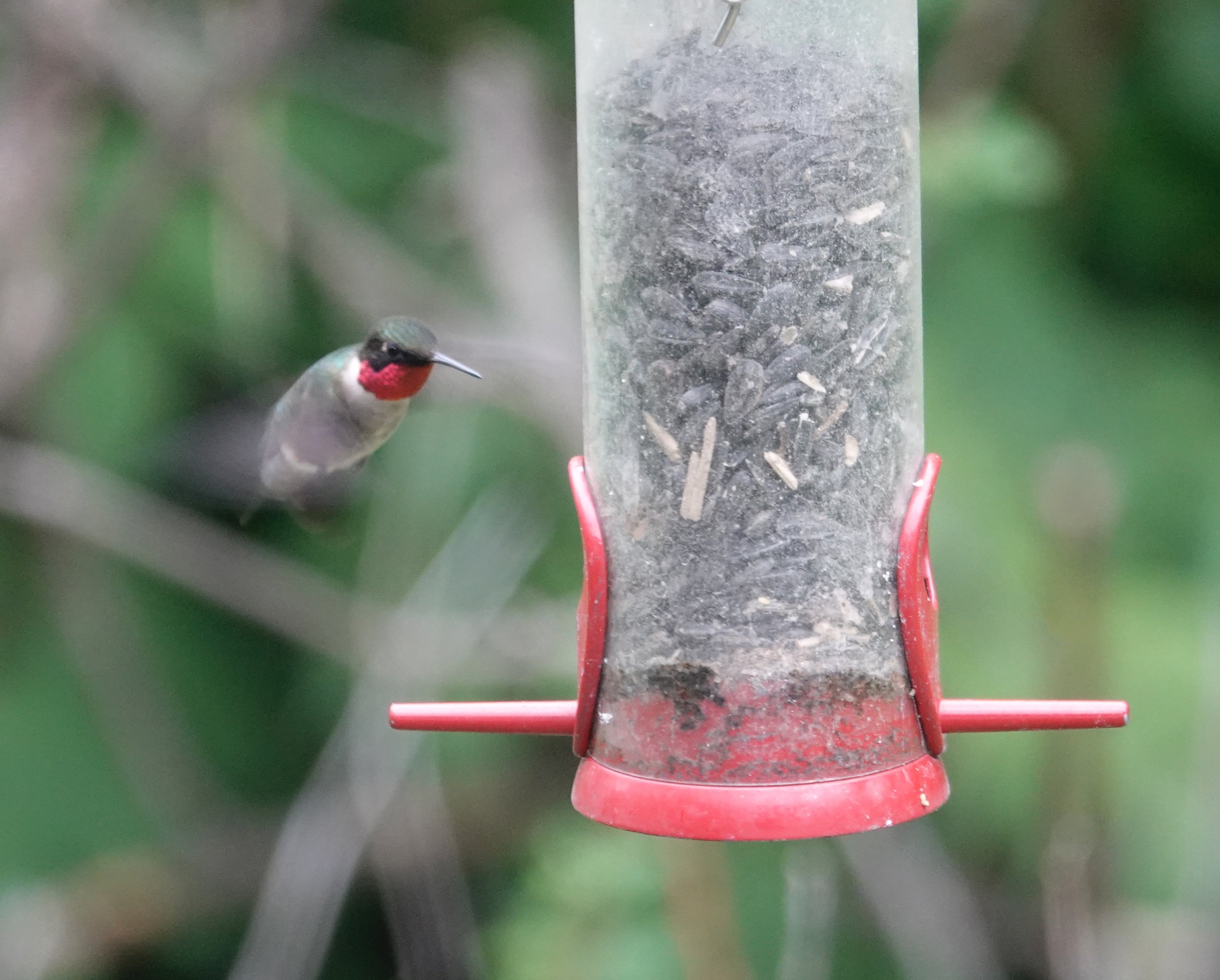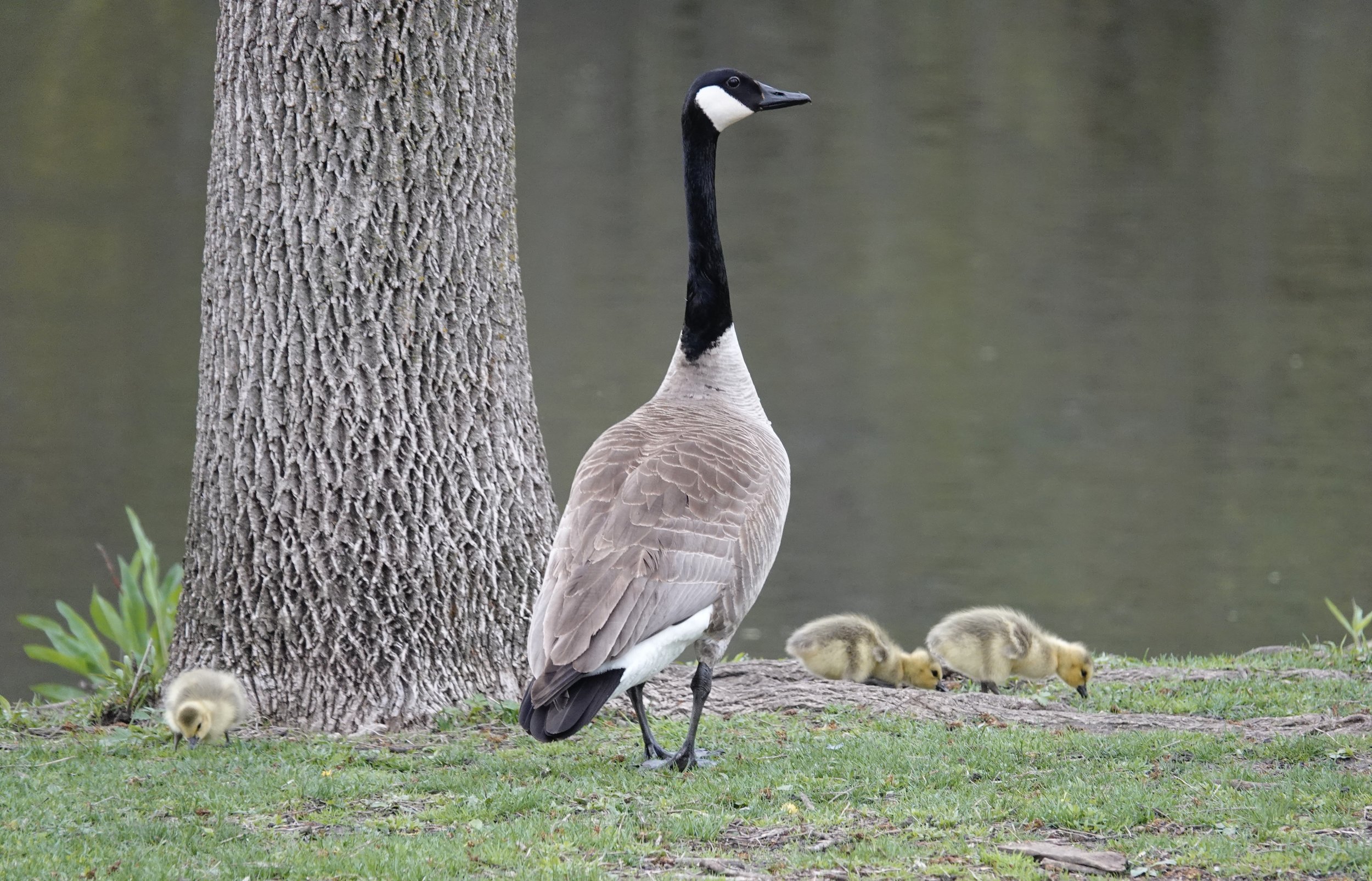What has cucumber-like spiny pods?
Nature by the yard
I use a heated dog dish as a birdbath. It thinks it’s a birdbath and I don’t have the heart to tell it otherwise. It works great even when its heater is on a summer vacation. That tiny body of water has brought me much pleasure. An orchard oriole spent time in the dish, splashing with a gusto nearly matching that of a Baltimore oriole. Then at dusk, an eastern screech-owl visited the pool. The tiny owls regularly use birdbaths for drinking and bathing. So many creatures use that birdbath, it wouldn’t surprise me if one of those ancient U.S. Navy frogmen that were available as toys in boxes of Kellogg's Corn Flakes and Kellogg's Frosted Flakes showed up. Little me put high-pressure propellant (baking powder) in a frogman’s foot and he went diving. A miniature frogman might be too much to hope for, but you never know what you’ll see when you watch birds.
Naturally
Lots of pelicans mean lots of bullheads in the lake. Lightning bugs or fireflies are neither bugs nor flies. They are beetles. Look for meadowhawk dragonflies to become common. On a warm August evening, common nighthawks fly graceful loops in the skies over the fairgrounds where I toiled. Their sharp, electric “beans” let me know they were chasing insects. Adult male hummingbirds and rose-breasted grosbeaks will soon scram, and robins will form flocks.
What’s that sound?
Bird songs have quieted, but insects call loudly to be heard. It’s usually the male that calls and the intensity increases at dusk and continues through the night. They aren’t using their voices, they use stridulation, the act of producing sound by rubbing two body parts together. The most well-known insects that stridulate are crickets. The snowy tree cricket, which is pale in color, inhabits woodland edges, bushes, small trees and vines. Often called the “temperature cricket” because it’s possible to tell the temperature by adding 40 to the number of chirps heard in 13 seconds. Nathaniel Hawthorne described its song as an "audible stillness" and declared, "If moonlight could be heard, it would sound just like that." Producers of movies and TV shows frequently dub its song onto soundtracks to signal that the action is taking place on a quiet summer's night in a rural or suburban setting.
The field cricket is a common household insect. This accidental invader is a large, shiny black cricket. It produces its chirping by rubbing its wings together to create the quintessential cricket song.
Katydids, resembling muscular green grasshoppers, call ch-ch…ch-ch-ch…ch-ch-ch. This is likened to the words ka-ty-did or ka-ty-didn’t.
A gray treefrog hunted on my office window on a warm night. The light attracted insects and that attracted the green predator (they come in various colors). I’ve been hearing their calls—territorial, I suspect.
Blooming but not idiots
Wild cucumber is a native, annual vine with hand-sized, star-shaped leaves. In early to mid-August, conspicuous small white to yellowish-green flowers grow. It’s noticeable along roadsides, forest edges, hedgerows and fences. The fruit is a small, cucumber-like spiny pod. Common burdock blooms. Tall woody perennials called meadowsweet bloom in white. Many yellow flowers can be seen now: black-eyed susans, yellow sweet clover, various species of sunflowers, common mullein, birds-foot trefoil, evening primrose and sow thistle. Expect to see goldenrod and asters blooming soon.
Q&A
“How many generations of monarch butterflies are there in Minnesota?” It takes monarchs approximately one month to go from egg to adult butterfly and there are usually four generations emerging throughout the year, three of which could be in Minnesota. The first three generations have lifespans of 2-6 weeks, with the fourth generation living 6-9 months and migrating (beginning in mid-August) to Mexico.
“How many cicadas can a cicada killer paralyze?” In a good year, the female wasp may create and fill more than a dozen nesting chambers, and may hunt and kill over 30 cicadas.
“Do you think the ivory-billed woodpecker still lives?” I don’t know. I hope so. It’s difficult to prove something doesn’t exist—take Bigfoot, for example.
“When do pheasants begin incubating eggs?” It generally occurs from April 1 through August 1, with an average hatch date of mid-June.
“Why so few mosquitoes this year?” Dry weather makes for less standing water for the skeeters to use for reproduction.
Thanks for stopping by
“Away, away, from men and towns, To the wild wood and the downs, — To the silent wilderness, Where the soul need not repress its music.”—Percy Bysshe Shelley.
“May the sun bring you new energy by day, may the moon softly restore you by night, may the rain wash away your worries, may the breeze blow new strength into your being, may you walk gently through the world and know its beauty all the days of your life.”―Apache blessing.
Do good.
©️Al Batt 2023
What is a herd of goats doing at St. Aidan Cemetery? Eating. Goats are browsers, not grazers, so they won’t mow your lawn, but 40 goats per acre will in a week’s time clear it of buckthorn, poison ivy, thistle, wild parsnip, ragweed, red cedar, garlic mustard and other brush and weeds. Photo by Al Batt.
The Freeborn County Fair is fairly fabulous
The original cracker barrel.
A hummingbird is a deadbeat dad
Naturally
Barn, bank, cliff and tree swallows are aptly named. Barn swallows nest in buildings. Thomas Jefferson called them American swallows. The barn swallow is the national bird of Austria and Estonia. In many cultures, a barn swallow nest in a barn or on a house is considered good luck. A Native American legend tells of a barn swallow that dared to steal fire from the gods and give it to man. In anger, the gods shot flaming arrows at the bird. One hit the swallow in the tail, burning away the central tail feathers. Since that day, the barn swallow has had what we consider a swallowtail. Cliff swallows nest on natural cliffs and manmade structures, such as bridges, culverts and sides of buildings. Bank swallows nest in financial institutions. Not really. They prefer exposed vertical sandbanks and bluffs. Tree swallows nest in dead trees, woodpecker holes and nest boxes. The name “swallow” is likely derived from the old English “swell,” meaning to swirl, a reference to the bird’s swooping flight, or from the old Norse “swala,” meaning a cleft stick, referring to its tail.
The Eagle Lady
I was thinning files when I came across a nice note from Doris Mager. I met Doris years ago. In 1979, she perched among the branches of a gangly pine for a week in a sturdy, inactive bald eagle nest 50 feet off the ground in Florida. Doris didn’t do this because no hotel rooms were available. She did it to call attention to the plight of the bald eagle, as a fundraiser and because she’d always wanted to sleep overnight in a nest. She’d devoted the previous 17 years of her life to rescuing and rehabilitating raptors. The Eagle Lady raised the funds needed to complete the construction of the Audubon Center for Birds of Prey.
Q&A
Ken Nelson of Clarks Grove asked when Baltimore orioles leave. As Baltimore oriole babies become independent, parents molt body and flight feathers, and some migrate in July. Migration for Baltimore orioles peaks in August and September.
“When do I hear cicadas in Minnesota?” We hear the sound of a distant buzz saw of the dog-day cicada in early July and it continues into September. Folklore says when you hear the first song of a dog-day cicada, frost is six weeks away.
“Do rootworms come at the time we first see fireflies?” It’s a common belief that the presence of fireflies in the evening is a signal that corn rootworm eggs might be hatching. The presence of lightning bugs doesn’t always mean that egg hatch is occurring.
“Does a male hummingbird help the female with nestlings?” Hummingbird moms are single mothers. Male hummingbirds provide no care to their offspring. They’re deadbeat dads. A father hummingbird is a faux pa. The female uses moss, lichens, grass and spider webs to build a nest in which she lays two tiny eggs.
“How does weather impact pheasants?” Hen health is of the utmost importance for a robust population. Egg laying, nesting, re-nesting and brood-rearing are taxing on hens. A mild winter allows hens to begin the spring reproduction season in top shape. The average clutch is 12 eggs. If a hen loses her nest due to cold weather, predation, haying or flooding, she’ll re-nest up to two times. A second effort averages eight eggs in a clutch, while a third re-nesting produces four to six eggs. Photoperiod is the primary factor, but temperature also affects when pheasants nest. An early spring could accelerate the pheasant nesting season by a few days. If the weather in April, May and June is warm and dry, hens have a good chance of pulling off successful first nests. Spring rain and cold weather affect chick survival, as they can't control their temperature until three weeks old. Pheasants have an annual survival rate of 50%, even lower in areas with inadequate habitat during a severe winter. Half the chicks don’t survive until fall due to predation or mortality from farm machinery and automobiles. By 17 or 18 weeks of age, chicks resemble adults in plumage. The winter wind that creates biting wind chills can be a blessing, as it blows farm fields free of snow and uncovers food. Hot dry summers can impede insect production, depriving chicks of the protein they need early in life. Drought conditions stunt vegetation growth, reduce the amount of cover and leave pheasants vulnerable to winter storms. Precipitation is essential, but too much or the wrong time can be the difference between a great and poor pheasant reproduction year.
Thanks for stopping by
“No matter how deeply you come to know a place, you can keep coming back to know it more.”—Rebecca Solnit.
“The best part of the journey is the surprise and wonder along the way.”—Ken Poirot.
Do good.
©Al Batt 2023
This eastern wood-peewee is a flycatcher with whitish wing bars and usually a pointy crest at the back of its crown. It whistles PEE-a-WEE and a down-slurred PEE-yer throughout the day. The similar eastern phoebe has a rounded head, indistinct wing bars, bobs its tail and calls its name with an insistent raspy “phoebe.” A pewee's bill has a yellowish-orange lower mandible and a blackish upper mandible, whereas the phoebe's bill is all dark. Photo by Al Batt.
We have received a welcomed rain.
Another day at the county fair with this humble correspondent
People were tasked with a mission improbable. They were given a bucket of junk and asked to make art. And did they ever!
Fair fare.
Awww…baby chicks.
The red and white stripes of the barber pole originated from a practice known as bloodletting. This practice involved drawing blood from a patient to treat an ailment. The red and white stripes represented blood and bandages, while the barber pole symbolizes the instrument people gripped onto during the procedure. Many barber poles have a blue stripe, which is likely a display of patriotism (the colors of the American flag).
From the Freeborn County Fair in Albert Lea, Minnesota
This unpretentious little barn has the capability of unleashing one of the most powerful forces for good known to man…the maple nut ice cream cone. Freeborn County Fair in Albert Lea, Minnesota.
A Bruno’s Corn Dog is a traditional; fair fare for me.
Ole and Lena are famous in Minnesota because of the endless supply of Ole and Lena jokes. This Ole and Lena are not those people and their onion rings and cheese curds are no joke. They are delicious.
This world-class popcorn has been provided to fairgoers by three generations of popcorn makers. It’s mighty good and then some.
Security abounds at the Fair.
A lot of people might find this tool useful after they take a long hike around the fairgrounds on a hot day.
Some wit had turned the “H” in “WITH” backward.
I love this from the 4-H Building.
Are woodpeckers obsessed with knock-knock jokes?
Naturally
I watched a ruby-throated hummingbird feeding. Pound for pound, a hummingbird isn’t. The miniature marvel weighs less than a #2 wooden pencil, a marshmallow or an AA battery.
After swallows finish nesting, they begin to gather in pre-migratory groups on utility wires in late July. They chatter excitedly about the gift of another day before starting a meeting without a single doughnut. It’s a migration planning session, covering the ins and outs of air travel, what to do in case of a hawk emergency and whether to eat dragonflies with wings on or wings off. The young stay with their parents during a diurnal migration undertaken by a flock. They leave here July-September so they can feed on flying insects with some swallows flying as far as Argentina.
Nature by the yard
There were two wild turkey hens with 15 poults in the yard. I see hens who have merged their families in the summer to raise and defend the poults. You who are members of a family or know someone who is a member of a family recognize that teamwork aids the survival of youngsters who can fly at 10 days of age. A hen will fake a broken wing to distract predators from her poults.
I watched a Baltimore oriole father showing three of his fledglings how to come clean in the birdbath. Two of them took to taking a dip like ducks to water. The third one, not so much. Pa left with the two swimmers, but the one with the dry feathers stayed behind to find a snorkel. He watched as a blue jay and a robin took their turns landing on the perching stone and splashing around. The hesitant oriole made a half-dozen attempts before finally landing on the stone. The bird touched one foot to the water and frightened itself away. No spot on the medal podium for it. I’ll save my applause for another time.
Bits and pieces on birding
John Lillich told me he’d happened upon a man on an Ohio nature trail who would have been naked if it weren’t for the binoculars around his neck. The man introduced himself as a naked birder.
Never put sunglasses or binoculars on the roof of your car. Sooner or later, you will forget them. If you need to rest them somewhere, set them against the windshield.
Are woodpeckers obsessed with knock-knock jokes?
If you can see birds, you should look at them.
Does a crow have cawer ID?
The song sparrow lives up to its name by being a persistent singer. Its scientific name Melodia means "singing" in Greek.
Q&A
“I know a chickadee and a killdeer call out their names. Do any other birds?” Humans gave birds names that were often imitations of their songs/calls, yet there isn’t a single bird species named chirp. Many suggest their names, some might require an imagination. Some of those birds are the phoebe, peewee, towhee, cuckoo, jay, bobwhite, kiskadee, willet, curlew, whip-poor-will, chuck-will’s-widow, hoopoe, kittiwake and chachalaca. Crow might be imitative of the bird's cry. A hummingbird should be on a list of birds with onomatopoetic names.
“What’s an easy way to tell a raven from a crow?” First, check the range maps. The much larger common ravens can be distinguished from American crows by their massive bills; by their tails, which come to a V (like the V in raven) behind them; and by their croak compared to a crow’s caw.
“Do monarch caterpillars use Indian hemp as a host plant?” Indian hemp is dogbane, the names referring to its supposed toxicity to dogs and its similarity to hemp. The perennial plant's strong fibers have made it prized for cordage and threads. Young dogbane plants are often mistaken for milkweed. Injured Dogbane oozes a white sticky sap with the consistency of latex paint. It’s native to Minnesota and was once thought to be a larval food for monarch butterflies, but research has shown that while female monarchs occasionally lay eggs on this species, their offspring will not mature on it. Dogbane grows 5 feet tall and blooms in white flowers in June-August. I enjoy seeing the iridescent, dogbane beetles on dogbane. The gold, blue, green, yellow and red insects are stunners.
“What are the tallest ferns?” It could be Fern Johnson. She used to be 6-2, but she might have shrunk with age. I don’t know another tall Fern, so you must be talking about plants. The ostrich fern grows up to 5 feet tall and the interrupted fern up to 4 feet.
Thanks for stopping by
“No matter how deeply you come to know a place, you can keep coming back to know it more.”—Rebecca Solnit.
“The best part of the journey is the surprise and wonder along the way.”—Ken Poirot.
Do good.
©️Al Batt 2023
The small, slender and long-tailed chipping sparrow is a beauty. Edward Forbush, a 19th-century ornithologist, called the dainty chippie “the little brown-capped pensioner of the dooryard and lawn, that comes about farmhouse doors to glean crumbs shaken from the tablecloth by thrifty housewives.” Its song is a rapid, mechanical-sounding trill. The chippie is nicknamed the “hair bird” because of its habit of lining nests with horse hair from deer, cows, horses and other mammals. Photo by Al Batt.
A skunk enjoyed a feast of mulberries. It didn’t raise a stink about the service.
A bee hotel.
A Double-crested Cormorant’s wings become waterlogged and it must wash and dry.
Mallards look for shade on a blistering, hot day.
I was listening for “Turkey in the Straw,” but found poults in the grass. Wild turkeys.
Long-horned bee.
It’s orange.
The strikingly handsome red-headed woodpeckers weren’t in numbers high enough to cause anyone to consider a hunting season
THEY’RE CHIRPER BY THE DOZEN
Naturally
I walked after dark. I walked after light, too. The yard bombilates day and night—the insects make a humming or buzzing noise. Not everything comes to those who wait, but mosquitoes do. I enjoy the finer things in life—fireflies, shining stars come to Earth to keep us company.
Earlier, a sliver of blue as intense as a summer sky zoomed by—a blue jay off on its daily errands. It made me feel like a star witness. I employ a lot of bird feeders because they’re chirper by the dozen.
House wrens sang a hymn to a summer day. Their songs came from everywhere and from nowhere. Other voices joined—robin, common yellowthroat, American redstart, red-eyed vireo, indigo bunting and goldfinch. A catbird practiced his repertoire. Fledged chickadees and their tuckered parents are a treat to watch and listen to.
For 30+ years of Junes, I’ve done a Breeding Bird Survey (BBS) covering parts of Mower, Freeborn and Steele Counties. I hope for a calm day, but some years the wind makes the tall grass dance the hula. A BBS is a frolicking foray away from life’s accustomed roads and a practice in mindfulness. I start at 5:02 a.m. and make 50 stops for 3 minutes each and tally every bird I see or hear. Like most things in life, it’s important to listen. Each year, the red-winged blackbird has been the bird I’ve counted most often. A BBS never fails to thrill and surprise. I heard a willow flycatcher call “Ah-choo.” Sandhill cranes appeared as usual, but trumpeter swans did not. I see one chimney swift each year—just one. The strikingly handsome red-headed woodpeckers weren’t in numbers high enough to cause anyone to consider a hunting season, but I saw a bunch. The collective noun for woodpeckers is a descent. I see a descent of flickers in my yard each year, but the red-headed woodpeckers were cleverly spaced for my constant amazement. I love a BBS—it keeps my 3-minute egg timer employed.
Japanese beetles are beautiful botherations that feed on over 300 plant species. I’ve read that starlings are prime predators of adult beetles. Garter snakes and grackles were mentioned. Japanese beetle white grubs feed on the roots of lawn grasses from June through the fall and skunks and raccoons tear up a lawn in pursuit of the grubs (crows eat any grub they find in those excavations) and chickens have plucked a few adults, but what else eats adult beetles?
Q&A
“Did the chipmunk get its name from its call?” Possibly. It's believed that the English word "chipmunk" was derived from "chetamnon," the name given to the animal by peoples of the Chippewa nation or from the Ojibwe word ajidamoo, which translates as "one who descends trees headlong."
“How can I make a puddling station for butterflies?” Fill a shallow clay or plastic bowl or saucer with sand. Mixing in a handful of compost adds more important nutrients. Add a few flat rocks to provide perches. Pour enough water into the container to moisten the sand. You might make it more attractive by adding overripe fruit like bananas and oranges. It could attract raccoons.
“I saw a squirrel lying on a branch in the shade with its legs splayed. What’s going on there?” This thermal regulatory behavior is called "splooting." An animal finds a cool surface and lies down on its stomach with legs spread to cool off. By putting as much of its core body on a cool space, the heat is transferred from its body to that surface. You'll see squirrels on a shady sidewalk, trail, branch or grass. The term sploot might derive from the word splat because of the splat-like (flat, spread-out) appearance of a sploot pose. Dogs and cats sploot, too. Splooting allows pets to cool themselves by pressing their belly onto the ground or against tile floors.
“Do purple martins eat 2000 mosquitoes a day?” Martins feed at 150-500 feet, which is higher than where mosquitos live. They eat a few mosquitoes, but not thousands. Purple martins forage during the day, while mosquitoes are most active during the evening. There isn’t much overlap in their schedules. Martins eat beetles, dragonflies, damselflies, cicadas, grasshoppers, katydids, moths, butterflies, wasps, stink bugs, mayflies, bees, midges, horseflies, termites, red fire ants and other insects.
“What is a mnemonic for a meadowlark?” A mnemonic is a sequence of words to help us remember something. The eastern meadowlark’s is, “I-DO-love-you spring-of-the-year.” The western meadowlark’s is, “Hip! hip! Hurrah, boys! Three cheers!”
Thanks for stopping by
“It’s amazing how lovely common things become, if one only knows how to look at them.”—Louisa May Alcott.
“Stop. Look. Listen. You are surrounded by countless little blessings but you’ll miss them if you don’t pay attention.”—Ruth McPherson.
Do good.
©️Al Batt 2023
Some might consider it an LBJ—a “Little Brown Job,” but the song sparrow is a subtle array of browns that vary in appearance. It pumps its tail in flight and its serenading song is a “sweet, sweet, sweet” followed by shorter notes and a trill. Photo by Al Batt.
Hairy vine, no friend of mine.
Naturally
I enjoy a drumroll when I leave the house. Why not? A woodpecker was happy to provide one by drumming on a resonant limb like John Bonham on the day he graduated from the School of Hard Knocks.
Each day, I listen to an eastern wood-peewee and his slurred whistle, a plaintive “pee-ah-wee” or “pee-wee” falling in pitch at the end. I have named him Herman. He’s a peewee Herman.
I watched turkey vultures soar with limited flapping. In Tibet, vultures are considered angels who bring souls to heaven where they can be reincarnated.
Crown vetch is a legume native to Europe and Asia. It was introduced to the US in the mid-1800s, and by the 1950s became widely planted. In Minnesota, it’s been planted as a cover crop and used for soil stabilization on ditch banks. Crown vetch flowers vary from white to pink to lavender and bloom from May through August. Similar plants show violet-blue flowers on cow vetch (bird vetch), and blue and white on hairy vetch. The flowers of cow vetch and hairy vetch are arranged in a line along the stalk, unlike the clustered arrangement at the top of crown vetch. Crown vetch has a leaflet at the tip of its leaves and doesn’t have tendrils at the tips as cow and hairy vetch do.
Purple coneflower, black-eyed Susan, the vibrant orange butterfly weed and vervain bloom. Hoary vervain grows with stalkless leaves in clumps in dry habitats. It might be confused with blue vervain, which has smaller flowers, stalked leaves and prefers moist habitats. Both bloom June-September.
Good morning eyeshine
Eyeshine, a visible effect of the tapetum lucidum, enhances animals' visual sensitivity in low-light conditions. A great horned owl flew from the road in front of my car. Its eyes glowed yellow. There is an overlap of colors, but raccoons, coyotes, deer and cattle have yellow eyeshine. Dog’s eyes are yellow, green or blue and cats are usually green, but can be orange, yellow or red. Horses are green to yellow to blue. Rabbits, opossums and foxes are red. Deer, coyotes and walleyes flash white eyes. Even the wolf spider has stars in its eyes.
Barn swallows
I mowed the lawn in the company of dive-bombing barn swallows that swooped along with me. They called “click-it” repeatedly, as if reminding me to fasten my seatbelt on my push mower. The swallow is an insectivore with flies, grasshoppers, crickets, dragonflies, beetles, moths and other flying insects making up 99.8% of its diet. A single barn swallow can consume 60 insects per hour or 720 per day. That’s 20,000 fewer insects per month that might bother you in your yard. Older siblings sometimes help their parents feed their young from a second brood. A study by the University of Berne, the University of Geneva and the Swiss Federal Institute for Forest, Snow and Landscape Research found broods of barn swallows receive 250-350 food portions daily, each containing 15-20 insects. Parental feeding accounts for up to 100,000 flying insects. A barn swallow weighs as much as 7 or 8 pennies and has been clocked flying 46 mph.
Poison ivy
Poison ivy wears disguises. Sometimes it looks like a thick vine winding around a tree and climbing high into the air. Sometimes it looks like a bush or a shrub. Other times it carpets the ground. Its “leaves of three, let it be” leaflets can have smooth or toothed edges and turn red, yellow or orange in the fall. Its white berries provide food for birds. About 85% of people are allergic to the urushiol oil within the plant. It has a hairy vine. “Hairy (raggy) rope, don’t be a dope.” “Hairy vine, no friend of mine.” “One, two, three. Don’t touch me.” "Berries white, run in fright” “Leaves of three, let it be; leaves of five, let it thrive.” Poison ivy leaflets are normally in groups of three, while those of Virginia creeper are in groups of five.
Q&A
“Why aren’t more athletic teams nicknamed the Robins?” I don’t know. There should be more. The Atlantic Collegiate Baseball League once had the Peekskill Robins as a member. The Brooklyn Robins (1914-1931) were in the MLB’s National League. They changed their name back to the Brooklyn Dodgers in 1932. They’re now the Los Angeles Dodgers. Some football clubs in England carry the name Robins, albeit a different Robin than the American robin. The same could be said for a couple of Australian Rules Football clubs. Robbinsdale Cooper High School Robins sounds good, but they’re the Hawks. Robins, Iowa, doesn’t have a high school. The Robins Robins is a keeper, but a friend would call them the Orange-bellied Worm Pullers.
Thanks for stopping by
"The butterfly counts not months but moments, and has enough time."—Rabindranath Tagore.
"Leave the roads; take the trails."—Pythagoras.
Do good.
©️Al Batt 2023
The adult ring-necked pheasant rooster has an olive crown bordered by feathers elongated to form hornlike or earlike tufts, red wattles above and below each eye, iridescent purplish head and neck, and a white collar. It has a spur on each leg. This rooster crows loudly in spring and summer. Its crow is often followed by a loud, rapid beating of the wings and it frequently cackles when it flies. The pheasant is a non-native introduced to North America in the 1880s as a game bird. Photo by Al Batt.
What did chimney swifts do before there were chimneys?
Naturally
I listened to the whistling wings of mourning doves as they took flight. The doves can hit a high speed of 55 mph. I found a nest that had likely taken a mourning dove only a few hours to build and it looked like it.
I watched nesting red-shouldered hawks from a friend’s place in Ohio as we ate lunch on the deck. The raptors brought in snakes and chipmunks for the dining pleasure of their babies. A tufted titmouse flew into its nest in a crack of a tree to feed its babies. It wasn’t much more than an arm’s length away from me. A study conducted in Germany found the more we see and hear birds chirping and singing, the happier we are. A team at the German Centre for Integrative Biodiversity Research discovered that being surrounded by a variety of birds offers increasing life satisfaction comparable to $150 per week of added income.
Q&A
“Were their chimney swifts before there were chimneys?” Before European settlement brought chimneys to North America, chimney swifts nested in caves, cliff faces and hollow trees. They are among the most aerial of birds, flying constantly unless roosting or nesting. Swifts bathe in flight: they glide down to the water, smack the surface with their bodies, and then shake the water from their plumage as they fly away. When they rest, they don’t perch like most birds, but cling to the walls of chimneys and other vertical surfaces. Unmated swifts continue roosting together in the summer, sometimes in large groups, but the species doesn’t nest colonially. Only one breeding pair nests in any one chimney regardless of its size.
“How do I set the diopter on my binoculars and what is the best way to focus on a bird?” Close your right eye and, using only your left eye to look through the binocs, and adjust the focus wheel until the object is clear. Next, close your left eye and, using the diopter adjustment, bring your view into sharp focus. See the bird with your naked eyes and lock your eyes on it while bringing your binoculars up to your eyes.
“What is the biggest insect in Minnesota?” I recall playing softball in Maple Island, when a good number of 2- to 3-inch-long giant water bugs, drawn by the lights, landed on the field. A giant water bug is an enormous insect with noticeable foreleg pincers used to catch underwater prey like small fish, frogs, newts and snails. A strong bite injects a solution that liquefies the insides of prey, allowing the bug to drink it. Its dark brown body is flat and oval-shaped. Unable to hold its breath, small breathing tubes called spiracles allow the bug to stay underwater while drawing in air trapped under its wings, like a straw. It’s known for biting toes when disturbed or threatened by people, earning it the nickname “toe-biter.” I’ve heard them called “alligator ticks.” It might be the largest.
“What animals eat mulberries?” Robins, cardinals, catbirds, crows, blue jays, Baltimore orioles, foxes, raccoons, chipmunks, skunks, opossums, squirrels, wild turkeys, brown thrashers, eastern bluebirds, great crested flycatchers, northern mockingbirds, rose-breasted grosbeaks, cedar waxwings, indigo buntings, tufted titmice, scarlet tanagers, northern flickers and me.
“I was on the Pelican Breeze boat with you when you pointed out the cliff swallow nests on a highway bridge. Do any other birds use them?” The gourd-shaped structures made of mud have been used by house wrens, house sparrows, eastern bluebirds, house finches, Say’s phoebes and chestnut-backed chickadees. A flock of swallows is a swoop or a flight. I think gulp would be a fine collective noun.
“Loons on our lake had three eggs. Is that common?” They generally have two eggs. Clutches of three or four eggs are rare and are likely from two females or are two clutches laid at separate times by one or two females.
“Are those morning glories growing on my fence lines?” The morning glory vine gets its name from the flower’s habit of opening with the first rays of sunshine and closing when the heat of the day arrives. It’s an ornamental species and an annual. You’re likely seeing a perennial bindweed (field from Eurasia) or hedge (a native) with funnel-shaped flowers that bloom mostly in the morning. Plants creep along on an herbaceous vine that clasps onto any substrate. Bindweed is a perennial vine with white or pink-tinged flowers and arrowhead-shaped leaves while morning glory is an annual vine with white, pink, purple or blue flowers and heart-shaped leaves.
Thanks for stopping by
“The invariable mark of wisdom is to see the miraculous in the common.”—Ralph Waldo Emerson.
“We are not the same persons this year as last; nor are those we love. It is a happy chance if we, changing, continue to love a changed person.”—William Somerset Maugham.
Do good.
©️Al Batt 2023
Japanese Beetles are beautiful botherations that feed on over 300 plant species. I’ve heard and read that starlings are prime predators of adult beetles. Garter snakes and grackles were mentioned as predators. I know skunks and raccoons tear up a lawn in their pursuit of Japanese Beetle grubs (crows feed on any grubs they find in those excavations) and chickens have plucked a few adults, but has anyone seen anything eating the adult beetles? Photo by Al Batt.
Who are you calling a dickcissel?
Naturally
A great horned owl flew in front of my car at 4 a.m. The headlights washed out its color. Later, a common yellowthroat called, “Follow me, follow me. Wait up, wait up.” A catbird, appearing tastefully dressed in a stylish gray suit, added scat, a vocal improvisation of jazz.
There were flying TVs—turkey vultures as I walked in woods where ticks, mosquitoes and deer flies were my grizzly bears. I strolled around a lake. No mosquitoes. A fellow told me that 95% of mosquitoes come from 5% of the water. That sounds right. Temporary water and changing water levels make for prime breeding habitats for many mosquitoes. Dragonflies, as larvae and adults, feed on mosquitoes. Go dragonflies!
I noticed tiny white, frothy blobs on various plants. They were produced by the nymphs of spittlebugs and the “spit” keeps the nymph from drying out and discourages predators. Adult spittlebugs, sometimes called froghoppers, resemble leafhoppers. They’re called froghoppers because their heads are elevated when at rest. Spittlebugs provide food for meadowlarks and other birds.
Wherever you go, there you are
I spoke at the 100th-anniversary celebration of the amazing Audubon Society of Greater Cleveland. Great people who do great things.
Matt Valencic and his wife have a horse. Dark-eyed juncos nest between the hay bales stored in the horse barn and have three broods per year. Juncos will nest in hanging flower pots or light fixtures. Matt was superb company as I tended to my steps on beautiful trails in northeastern Ohio. They were up and down, but hospitable. I listened to an eastern towhee call “say towhee” and a willow flycatcher utter “ah-choo.” A red-eyed vireo, which my father called a “preacher bird,” because it went on and on, was counting the leaves of the tree it sang from. Mnemonics for its song include: “Look at me. Way up high. Over here. In a tree.” and “Here I am! Where are you?”
I joined a nature hike led by a remarkable optometrist named Jim Tomko from Aurora, who saw everything in nature. A big man named Kenny walked with me. Another hiker told the story of being unable to spot a scarlet tanager (it’s the color of a cardinal with its lights on) in a giant tree. Kenny thumped the tree with his bare hand and the bird flew from it.
John Lillich led a walk through the lovely Hach-Otis Sanctuary in Willoughby Hills. John tries to be two things each day, a student and a teacher. I can attest he’s an outstanding teacher. He showed me a couple of American chestnut trees. American chestnut trees once made up 25% of forests in eastern North America and were so plentiful, folklore says a squirrel could have traveled the chestnut canopy from Georgia to Maine without ever touching the ground. The trees grew to 120 feet tall and lived for 600 years with straight, light and rot-resistant wood. The fungus that wiped out the trees was found in 1904 in New York and by 1912, all the chestnut trees in New York City were dead. By 1950, 90% of the species had died. I met two trees that had survived.
Q&A
“How did the dickcissel get its name?” The unusual name comes from its song, a sharp “dick dick dick” followed by a buzzed “ciss, ciss, ciss.” Some people call the bird the “little meadowlark,” because its appearance suggests a miniature meadowlark.
“Why do bats fly close to humans who worry bats might become tangled in their hair?” Folklore asserts a bat will stay tangled in hair until driven out by thunder and lightning. Bats fly low over the heads of people because they are in search of insect prey, not hair. The activities of people flush insects.
“Why do bats hang upside down?” Most birds have hollow bones, bats have solid bones and hanging upside down allows them to drop and gain momentum for flight.
“What kind of rabbit is Bugs Bunny?” Without a DNA analysis, I can’t be sure, but I don’t think he’s a rabbit. Looking at the length of his ears and legs, he’s a hare. Hares have precocial babies, born furred, open-eyed and ready to run. Rabbits have altricial babies, born hairless, with eyes closed and dependent on mom.
“Do carpenter ants eat wood?” Carpenter ants don’t eat wood. They’re too busy doing kitchen remodeling. Carpenter ants nest in hollow areas and inside damp wood. If you have trees, you’ll have carpenter ants.
John Ruud of Albert Lea asked what baby wood ducks eat. They eat insects, algae, small fish, duckweed, aquatic insects and invertebrates.
Thanks for stopping by
“What the Caterpillar calls the end of the world, the Master calls a butterfly.”—Richard Bach.
“We shall never know all the good that a simple smile can do.”—Mother Teresa.
Do good.
©️Al Batt 2023
A fishing spider, sometimes called a dock spider, is associated with water but is also found away from it. It skates on the water’s surface by using the surface tension. It dives underwater to prey upon aquatic insects, tadpoles and small fish. This large spider is shy and not harmful to humans. Photo by Al Batt.
Goldfinches are feathered lemon drops
Naturally
Goldfinches are more vibrant than lemon drops. I spotted a crow on a low-hanging branch. It was a young crow with lovely blue eyes. Each crow in the murder had a cow, and they let me know what they thought about me messing with their beloved fledgling.
Our Audubon group’s purple martin houses and gourds have 147 eggs. We have great eggspectations.
As I walked, I found joy in the company of an American redstart. Warblers are the butterflies of the bird world and the American redstart exemplifies that nickname. The redstart flits about in the trees, holding its wings and tail partly spread. The adult male has a glossy black plumage set off by vivid reddish-orange patches on its sides, wings and tail. Females and young birds, often called "yellowstarts," are grayish, with yellow patches on the sides, wings and tail. The word "start" comes from an Old English word for "tail.” An American redstart constantly flicks its tail open and closed like a fan, flashing patches of bright orange or yellow. This is thought to startle insect prey and allow the birds to nab them. In Latin America, the bird is often called candelita, or "little candle."
Others accompanying me on my walk were dragonflies. The handsome insects collect nicknames: devil’s darning needles, mosquito hawks, snake doctors, horse stinger and ear cutter. Each spring and fall, large dragonflies called green darners fly across North America, traveling as far as 900 miles on two-inch wings. These dragonflies leave Minnesota in July through October to head south, flying as far as 87 miles per day. Kestrels eat them, as their migrations coincide in both time and location. At migration’s finish line, the dragonflies lay eggs and die. A new generation makes its way north in the spring. Some green darners don’t migrate and overwinter in Minnesota as naiads in ponds and emerge as adults in the spring.
Q&A
“Are all mergansers cavity nesters?” Not quite. Common mergansers nest in natural tree cavities or holes carved out by large woodpeckers. Sometimes in nest boxes, provided the entrance hole is large enough. They might use rock crevices, holes in the ground, hollow logs, old buildings and chimneys. Hooded mergansers readily nest in boxes. Red-breasted mergansers nest on the ground along forested riverbanks, marsh edges, lakeshores, coastal islands and sandy shores.
“What percentage of turtle eggs hatch?” In northern New York, raccoons destroyed 94% of all snapping turtle nests identified in one turtle nesting study. During a six-year study on the reproductive and nesting ecology of snapping turtles in southeastern Michigan, predation rates averaged 70%. The majority of nests were devoured by raccoons within 24 hours of egg deposition. In Ontario, raccoons and coyotes were observed following the tracks of early-emerging hatchlings back to their nests and consuming eggs and young remaining in the nest cavity. Predators may smell their way to nests, guided by the scent of embryonic fluid or a rotten egg.
“When do red foxes have pups?” Red foxes mate in February and 52 days later, 5 to 10 pups or kits are born. They nurse for 10 weeks and are independent at 7 months of age.
“What do fireflies eat?” Firefly larvae are carnivorous and eat snails, slugs, worms and other larvae. Depending on the species, adults eat other fireflies, nectar and pollen, or eat nothing at all.
“Can I destroy house sparrow and starling nests?” You can because house sparrows and European starlings aren’t protected by the Migratory Bird Treaty Act. Under the MBTA, it’s illegal to destroy a nest that has eggs or chicks in it or if there are young birds that depend on the nest for survival. There are a few other exceptions. It’s also illegal for anyone to keep a nest without a permit to do so issued by the U.S. Fish and Wildlife Service.
“What do house sparrows eat?” Once commonly called English sparrows, they order from an expanded menu, eating mostly grains and seeds, livestock feed and discarded food. They happily visit birdfeeders and chow down on millet and sunflower seeds. During the breeding season, house sparrows eat insects and feed them to their young. They catch insects in the air and on the ground, stalk lawnmowers and visit lights at dusk. I watch them feeding on insects cooked on grilles and radiators of automobiles.
Thanks for stopping by
“Life can only be understood by looking backward; but it must be lived looking forward.”—Soren Kierkegaard.
“There are two kinds of people in the world, those who believe there are two kinds of people in the world and those who don't.”―Robert Benchley.
Do good.
@Al Batt 2023
This is a female widow skimmer. The males of this dragonfly species leave the female alone while she lays her eggs, making her a “widow” in the process. Another reference to the “widow” name suggests the dark basal portion of the wings looks like a widow's black mourning shawl. Adults eat almost any small, soft-bodied flying insect, including mosquitoes, sweat bees, hoverflies, flies and flying ants. Photo by Al Batt.
Adult Japanese beetles feed on more than 300 plant species. Photo by Al Batt
The magic of Merlin
Naturally
I watched a couple of turkey vultures make Venn diagrams in the sky and spotted hoofed ruminants that are deer to us. A crow dipped a colorful snack bag in the water of a pond. I don’t know what was in it. Crows are notorious for soaking food in water. They’re not cleaning it and it's more than softening the food to make it more palatable. Baby crows rely on parents to provide foods containing enough moisture to prevent dehydration and moistened food helps.
Serviceberry, also called juneberry, shadbush or Saskatoon berry, is a small tree or shrub native to Minnesota. Ripe fruit can be eaten fresh or used in jams, jellies and pies. Serviceberry is attractive to pollinators, birds and other animals. One story maintains the first settlers in the New England area planned funeral services at the same time the tree bloomed, a sign the ground had thawed sufficiently to dig graves. The tree became known as the serviceberry. This origin is disputed.
Wild ginger, sometimes called woodland ginger, Canada ginger, snakeroot, colic root, coltsfoot, namepin and sturgeon potato. It has fuzzy, green, heart- or kidney-shaped leaves and below them is a small brown to burgundy, bowl-shaped flower. The color and scent of the blooms attract early spring gnats, flies and beetles. The flowers smell like rotten meat, although the scent isn’t noticeable to me.
Spring ephemeral wildflowers, like trilliums, Dutchman’s breeches, violets, hepatica, rue-anemone, bloodroot, and trout lilies make the most of their limited time, by using ants as a strategy for seed dispersal. Spring ephemerals are pollinated by bees, wasps, beetles and other insects, but ants spread the seeds from May through July. Seed dispersal by ants is called myrmecochory.
Male hummingbirds aggressively protect their territories, chosen because of an abundance of food, nectar and water. Male hummingbird territories are about a quarter acre. Females define their territories by the area around their nests. Both male and female hummingbirds are fiercely protective of their turf. Males are more likely to exhibit territorial behavior around backyard feeders or flowers.
Merlin
What was that bird you heard? If there only was an app that could tell you. There is a free app. It’s called Merlin, created by the Cornell Lab of Ornithology. One of the app’s features is called Sound ID, which analyzes audio in real time. Discover feathered neighbors by opening the app, clicking “Sound ID” and pressing the microphone icon. The app records all sounds, suggesting bird identifications. It’s that simple.
Q&A
“How do I know if a baby rabbit has been abandoned? Baby cottontail rabbits leave the nest when they're around three weeks old and about the size (5 inches long) of a chipmunk minus its tail. If you find one that size that’s fully furred with eyes open, ears erect and the ability to hop, they are independent.
“Am I seeing Dame’s rocket or phlox?” Dame’s rocket is a Eurasian biennial introduced to North America in the 1600s and is often included in wildflower seed mixes. The plant has a three-month-long (May-August) blooming period of loose clusters of attractive, fragrant, pinkish-purple to white four-petaled flowers on 2 to 4-foot stems. Dame’s rocket is confused with phlox, but phlox has flowers with five petals and dame’s rocket has four.
“Do pigeons recognize themselves in a mirror?” Some scientists believe so, bringing the number of birds that have shown some awareness of their reflections to four: Adélie penguins, Eurasian magpies, Indian house crows and pigeons. Recent research has found that pigeons don’t pass the classic MSR test in which animals have a spontaneous reaction to touch a mark on their body visible only in a mirror, but they may be conditioned to do so.
“What do pelicans eat?” American white pelicans primarily eat rough fish, but also feed on crayfish and salamanders.
“Don’t fawns have a smell?” It's a commonly held belief that white-tailed deer fawns are born without a scent, but it's not quite true. They have a scent at birth, but it's faint. During the first few weeks of life, the fawn’s primary defense against predators is to hide. Fawns may not be odorless, but their scent glands aren’t fully developed.
“Do loons have hollow bones?” The bones of most birds are hollow and light, but loons have solid bones. The extra weight helps them dive as deep as 250 feet in search of food and stay underwater for up to five minutes. Grebes and cormorants also have solid bones.
Thanks for stopping by
“The wonder of the world, the beauty and the power, the shapes of things, their colours, lights and shades—these I saw. Look ye also while life lasts.”—Seen on an old tombstone in Cumberland, England.
“We will be known forever by the tracks we leave behind.”—Dakota proverb.
Do good.
©️Al Batt 2023
Female indigo buntings are a soft brown with faint streaking on the breast, but an older female might have a hint of blue on her wings, tail or shoulders. She chooses the nest site and builds the nest alone. Her “blue canary” mate looks incredibly handsome while she completes that task. Photo by Al Batt.
Download the free KMSU app, go to On Demand and get past shows. Thank you.
Become a birder watcher
Naturally
Cottonwood seed fluff wafts through the air starting in May and lasting through mid to late June.
I peered through the glass to see samaras. More commonly referred to as helicopters, whirlers, twisters, spinners or whirligigs—samaras are the winged seeds produced by maple trees. Maple trees produce these winged seeds, but red, silver and Norway maples produce the largest quantities. Silver maples drop theirs in late spring. Red maple in late spring or early summer and fall. Sugar maple samaras ripen from early summer into fall. Red maple samaras are red, in contrast to those of sugar maple, which are green in spring. Box elder samaras are 1 to 1-1/2-inch-long V-shaped pairs that are winged and similar to those of a sugar maple but smaller and ripen in late summer or early fall; often staying on trees all winter. Maples have a baseline number of seeds they produce each year. Most are eaten by squirrels, chipmunks and other animals. Every few years, maples produce a glut of seeds, which give the trees a better chance of producing viable seedlings and the seed eaters more than enough food. The theory is this overwhelms the animals that eat the seeds.
Snappers
Snapping turtles are Minnesota’s largest turtle. They can weigh 65 pounds with upper shells (carapace) that measure 20 inches from front to back, but that size is rare. Most snapping turtles weigh 10 to 35 pounds and have shells ranging from 8 to 14 inches long. Male snapping turtles are bigger than females and their tails are proportionally longer. Snapping turtles are sexually mature when their shells are about 8 inches long and that takes 8-10 years. A clutch of 20-30 eggs is laid in May and June on sandy riverbanks, open fields, road embankments, trails, muskrat houses and lawns. Most nesting activity occurs in the early morning or late evening, especially on warm rainy days. Females use their hind legs to dig a 4-8-inch-deep nest. The white eggs have a tough, leathery shell and are shaped like ping-pong balls. Eggs take 55 to 125 days to hatch depending upon the weather, but most hatch in 60 days. Hatchlings have a shell length of about one inch. Many of the eggs are eaten by raccoons, skunks, coyotes, opossums or foxes in the first day or two. I’ve read that only 5% of eggs hatch and only 1% survive to a reproductive age. Female snapping turtles can live to be 50 years old.
Frequent flyer miles
Blackpoll warblers are long-distance athletes and hold the record for the longest over-water flight for a songbird. Each fall, these half-ounce warblers migrate 1,800 to 2,000 miles across open water without stopping. They sometimes fly more than 80 hours at a time until they reach their Amazon wintering grounds.
A painted bunting
Ben Marti was riding his bike through Mankato’s Rasmussen Woods and on the Red Jacket Trail when he came upon people pointing or using binoculars and cameras. He stopped and was told that a rare bird was being seen—a painted bunting. The painted bunting is split into two geographically isolated populations. One breeds across a wide swath of the south-central United States and in Northern Mexico, with a range covering parts of Texas, Oklahoma, Louisiana and Arkansas, and parts of Mississippi, Kansas and Missouri. The much smaller eastern population occurs along a narrow strip of the Atlantic Coast, from Florida to North Carolina.
Ben didn’t have to look long. The bunting landed on the trail. The strikingly colored male painted bunting has a blue head, red underparts and yellow-green back. This dazzling bird turns the heads of birders and nonbirders alike.
Did this make Ben a birder? Not yet. Maybe he’ll become a birder one day, but for now, he’s a birder watcher. He plans on stopping his pedaling whenever he sees a group of them. No telling what he might see.
Q&A
“Am I seeing a swift or a swallow?” Swifts are gray-brown with bodies often referenced as “flying cigars.” Their narrow and curved wings move with quick, shallow wingbeats. Their tails are short and squared at the tip. Swifts can be confused with swallows. If you see flashes of blue or orange, that’s probably a swallow. If the bird has long, skinny wings that look like they’re fluttering, that’s a swift. If they have thick wings tapering near the ends, that’s a swallow. Swifts tend to hunt high above, over buildings or trees, while swallows are likely to swoop low.
Thanks for stopping by
“Only if we understand, can we care. Only if we care, we will help. Only if we help, we shall be saved.”―Jane Goodall.
“Every time you smile at someone, it is an action of love, a gift to that person, a beautiful thing.”—Mother Teresa.
Do good.
©️Al Batt 2023
The double-crested cormorant was a common and abundant breeding bird throughout much of Minnesota in the presettlement era but was nearly extirpated by the late 19th Century. Because their feathers are not waterproof, double-crested cormorants often spread their soaked wings to dry after a dive. This incomplete waterproofing helps reduce buoyancy, a valuable attribute for a diving bird. Their aquamarine eyes are arresting. Photo by Al Batt
Upsy daisy, you lovely oxeye daisy.
You can see that carpenter ants have been working here. They left a couple of Phillips screws as clues.
Monarch butterfly caterpillars. They grow up so fast.
Something tells me there’s something good about seeing a black squirrel that’s seeing me.
How does a baby cowbird know it’s a cowbird?
Naturally
I saw so many deer, I expected to see one at the gas pumps. Karl Miller, Professor of Wildlife Ecology at the University of Georgia School of Forest Resources and a foremost authority on whitetail deer, says the U.S. deer population was estimated to be 25-30 million in Christopher Columbus' time. Hunting and habitat loss greatly reduced deer populations through the years. By 1900, their numbers had declined to 350,000. Since then, deer populations have surged to about 30-35 million as a result of the elimination of predators (like wolves), wildlife conservation efforts and controls on hunting.
I heard a barred owl call. “Who cooks for you? Who cooks for you all?” Harriet Tubman
is known for her work on the Underground Railroad and as a scout, spy, guerrilla soldier and nurse for the Union Army during the Civil War. She was also a naturalist who used the call of an owl to alert refugees and freedom seekers to come out of hiding and continue their journey of escape from slavery. The call used was believed to have been that of the barred owl, sometimes called a hoot-owl.
Would you like to see hummingbirds? Go to West Texas to see them without going to West Texas. You’ll find busy feeders here https://www.allaboutbirds.org/cams/west-texas-hummingbirds/?
Q&A
“Can birds see in total darkness?” Nocturnal birds such as owls have amazing night vision that allows them to hunt at night, but it’s believed that birds aren’t able to see in total darkness. Owls have forward-facing eyes, a feature they share with many predatory animals. Prey animals tend to have eyes on the sides of their heads, which gives them a wider field of view and a better chance of spotting predators. An owl’s enormous eyes help it take in enough light to see and make up as much as 5% of the bird’s total body weight. For comparison, our eyeballs are about 0.0003% of our total weight. Some owls can hunt by sound alone and can catch prey in a pitch-black environment.
“Would a plastic owl keep squirrels away from my deck?” No, squirrels have a good sense of smell. It may look like an owl, but it smells like a discarded Lego.
“What kind of duck is called a ‘butterball’?” It’s the bufflehead. The bufflehead name refers to the duck having a head like a buffalo, large and blocky. Other nicknames include little black-and-white duck, bumblebee duck, buffalo-headed duck, little dipper and spirit duck. The bufflehead is so cute, it could be the chickadee of ducks.
Neil Opstad of Albert Lea asked where the Baltimore orioles go. Some nest in your neighborhood, but they breed from Louisiana through central Canada. They leave as early as July for wintering grounds in Florida, the Caribbean, Central America and South America’s northern tip.
“Why do so many people hate wolves?” I think much of it is because of fairy tales like Little Red Riding Hood.
Roger Truax of Albert Lea wondered what the most common hawk is in Minnesota. Red-tailed hawks are here year-round, are the most commonly seen raptor in the Gopher State and are the most common hawks in North America. They’re the large highway hawks that find roads to be excellent hunting grounds.
“How does a baby cowbird know it’s a cowbird and not its host species?” This bird is an obligate brood parasite. It lays its eggs in the nests of other species. Scientists discovered fledgling cowbirds leave their foster parents’ care at night to sleep away from them in open fields, where they learn the ways and songs of fellow cowbirds. Research found a cowbird’s brain is hard-wired to recognize a sound that triggers the start of its journey to cowbird identity. The researchers call this a chatter password, which is the sound female cowbirds make when visiting the nest areas of their young ones. This special password guides species-specific recognition.
“Why do some birds hop and others walk?” In general, small birds that spend most of their time in trees, where they hop from branch-to-branch feeding, will also hop when on the ground. Birds that spend much of the time feeding on the ground or at ground level rather than in trees, tend to walk. There are exceptions and most birds are capable of doing both.
“Do pigeons mate for life?” Generally, they do. Parents take turns incubating eggs and feeding the squabs a crop secretion called pigeon milk.
Thanks for stopping by
“If love is in the air, it must surely be a bird.”—Jesus Antonio Moo Yam.
“We cannot protect something we do not love, we cannot love what we do not know, and we cannot know what we do not see. Or hear. Or sense.”—Richard Louv.
Do good.
©️Al Batt 2023
The orchard oriole is smaller than the Baltimore oriole and less often encountered in yards or parks. The orchard oriole’s bubbly song is a sweet, musical warble, more delicate and less repetitive than a robin’s. This photo of a male orchard oriole by Al Batt.
How big is hope? It’s the size of a hummingbird.
Naturally
Colorful spring birds are part of nature’s sneaky plan to get us to pay attention.
If you're on a country road and see random lilac bushes, there was likely a house or farm there once. George Washington and Thomas Jefferson grew lilacs in their gardens. Margaret Millar wrote, “The smell of moist earth and lilacs hung in the air like wisps of the past and hints of the future.”
How big is hope? It’s the size of a hummingbird. I hope to see one each of the days they should be here. A pine siskin joined the goldfinches at the Nyjer feeder in my yard. It was welcomed with open beaks. A concert performed by whistling rose-breasted grosbeaks thrilled me. Those birds are said to sound like a robin that has had singing lessons.
A pair of red-headed woodpeckers continues to enjoy the complimentary breakfast provided by their humble servant each day. The scarlet tanagers landed and monarch butterflies fluttered by. A few warblers here and there—more there than here.
Air rushing over the Wilson's snipe's outspread tail feathers created the haunting hu-hu-hu winnowing sound. They usually produce the sound when they dive.
I heard “Look at me. Way up high. Over here. In a tree.” That’s a mnemonic for the red-eyed vireo. According to Guinness World Records, a red-eyed vireo holds the record for singing the most songs, with 22,197 sung in 10 hours.
Lake Sagatagan is in the St. John’s Abbey Arboretum. The surface area is 176 acres with a maximum depth of 40-42 feet. Lake Sag is a natural kettle or pothole lake with no direct water inputs or outputs and is recharged by underground springs plus rain and snow from the surrounding land. The lake was originally called Lake Saint Louis after King Louis of Bavaria and changed to Sagatagan, an Ojibwe word meaning punk or fungus outgrowth on trees used for tinder. I walked the trails there and listened blissfully to sandhill cranes calling back and forth, and hearing wood thrush sing, “Frito-Lay.” Aldo Leopold described the songs of a crane as, “High horns, low horns, silence, and finally pandemonium of trumpets, rattles, croaks, and cries that almost shakes the bog with its nearness, but without yet disclosing whence it comes.” In Greek mythology, the alphabet was said to have been invented by the god Mercury while observing cranes. Thoreau described the sound of the wood thrush this way, “It lifts and exhilarates me. It is inspiring. It changes all hours to an eternal morning." I took the time to feed the mosquitoes. My blood will grow baby mosquitoes that might bite me someday.
Q&A
“Who raises the most sunflowers?” North Dakota was the largest producer of sunflowers in the United States in 2022, followed by South Dakota and Minnesota. Russia and Ukraine are the two countries that grow the most sunflowers.
“Is the mourning dove the ‘rain crow’?” The yellow-billed cuckoo is a rain crow, sometimes called a storm crow because of the bird's habit of calling on hot days, often presaging thunderstorms. Merriam-Webster Unabridged Dictionary says rain crow is the black-billed or the yellow-billed cuckoo and the rain dove is a nickname for the mourning dove.
“The stripes on the heads of white-throated sparrows vary in color. Why?” The striking stripes on the heads of white-throated sparrows are white or tan. Author Pete Dunne said, “White-throated Sparrows come in two plumages—stunning and shabby.” The two color forms are genetically determined. The males prefer females with white stripes and the females prefer tan-striped males.
“When do wild turkeys nest?” The breeding season is April and May. Hens lay 8-15 eggs and don’t incubate until they lay the last egg. It takes 28 days to hatch and the chicks leave the nest within a day. The young, called poults, can fly in three or four weeks, but stay with their mother up to four months. Renesting after losing eggs is normal.
“Did ‘take a gander’ come from a gander?” The use of gander to mean look comes from the long, flexible neck of the goose (like a gooseneck lamp). A rubbernecking gander plays sentinel, craning his neck to examine any intruder.
Thanks for stopping by
“No man treats a motorcar as foolishly as he treats another human being. When the car will not go, he does not attribute its annoying behavior to sin; he does not say, ‘You are a wicked motorcar, and I shall not give you any more petrol until you go.’ He attempts to find out what is wrong and to set it right. An analogous way of treating human beings is, however, considered to be contrary to the truths of our holy religion.”—Bertrand Russell.
“Those who pass through life without stopping to admire the beauty, organization, melody or habits of birds rob themselves of a very great share of the pleasures of existence.”–Jacob Giraud.
Do good.
©️Al Batt 2023
“In all of North America, only a handful of animal calls have the power to stir the human soul as profoundly as these crane calls. The yodeling of loons on a northwoods lake, the bugling of elk across a misty meadow, the lugubrious howling of a wolf pack in a wilderness forest—these are sounds that bypass the ears to sink their teeth into a nerve deep within the listener, these and the ancient gurgling cries of cranes echoing over a dark river.”—“The Cry of the Sandhill Crane” by Steve Grooms. Photo by Al Batt.
How do seagulls find my tractor when I’m working in the field?
Naturally
The alarm sounded. A rooster pheasant had crowed “cow-cat.”
The Nyjer feeders were weighed down with a gazillion lemony goldfinches—maybe fewer.
I listened to a brown thrasher sing about his experiences. His song was a clear and melodious set of repeated phrases sung with gusto, with one mnemonic spoofing a phone conversation, “Hello! Hello! Yes, yes. Who is this? Who is this? I should say! I should say! How’s that? How’s that?” Al Sack of Harmony sent me a photo of a brown thrasher nest in a roll of old barbed wire.
I attended a visitation for LaMoyne Heidemann of Albert Lea. His wife Marge told me the grosbeaks and orioles were back in their yard. She’d always alerted her husband when that happened and he hurried to the window where they looked at the birds together. How fortunate we are when we have someone willing to look in the same direction we are.
Reports of Baltimore orioles
Rick Mammel of Albert Lea saw a couple of Baltimore orioles in his yard. He put orange halves and grape jelly in an oriole feeding station he’d constructed. He said it hadn’t taken two minutes before two orioles began feeding.
Maren Holst of Lake City had seen some orioles late in the day. At 10 minutes before midnight, she put out oranges for them. She’d forgotten to do that earlier and wanted to make sure the birds had breakfast.
Denny Tostenson of Albert Lea had asked me to send him some Baltimore orioles. He called later to say he wanted some, not the whole flock. He wondered if he could afford to feed them all.
Q&A
“Why do I see bald eagles and turkey vultures hanging around together?” They are both scavengers and soar on thermals. They could unknowingly help the other find food. An eagle might catch a fish or other prey item and not clean its plate, leaving tidbits for a vulture. Vulture talons aren’t meant for transporting food, so they carry it in their crops to regurgitate for their ravenous chicks. The vulture may look ominous when standing in a spread-winged stance called the horaltic pose. The stance likely serves multiple functions: drying the wings, warming the body and baking off bacteria.
“Why do swans congregate in Monticello in the winter?” Up to 3,000 trumpeter swans gathered in the water of the Mississippi River kept open by warm water discharged from a power plant. In 1986, a swan showed up on the river outside Sheila and Jim Lawrence's front door. Sheila, "The Swan Lady," began feeding the swans. Every day, she did swan chores, feeding over 1,500 pounds of corn from plastic buckets. Geese and ducks found their way to that trough too. Sheila died of cancer in 2011. Her husband continued the meals until the artificial feeding program ended in 2020 as wildlife officials encourage the swans to feed naturally. Trumpeters were driven to near extinction from the widespread destruction and degradation of wetlands and hunting. By the 1880s, trumpeter swans were extirpated from Minnesota. By the 1930s, only 69 trumpeter swans remained in the lower 48 states. Thanks to the good work of many, there are now 30,000 trumpeter swans in Minnesota. A male swan is a cob, a female swan a pen and a baby a cygnet. They have a 7–8-foot wingspan and an all-white plumage—the much smaller snow goose has black wingtips. In the movie “Heartburn,” an account of Nora Ephron’s ill-fated marriage to Carl Bernstein (played by Jack Nicholson), the distressed protagonist (played by Meryl Streep) told her father of her husband’s infidelities. He advised, “You want monogamy? Marry a swan.” Trumpeter swan pairs stay together throughout the year and are assumed to mate for life, but some individuals do switch mates and some males that lost their mates don’t mate again.
“How do seagulls find my tractor when I’m working in the field?” Although most people call them seagulls, that term is taxonomically wrong and misleading. Gulls are found nearly everywhere, especially where there is a landfill. The term gulls is better, but if you say “seagulls,” I’ll know what you mean. So, the gulls are flying high overhead. This means they can see a large area. A flock has many eyes to look for food. If they see other birds feeding, they check it out. If they see your tractor moving across a field, they have learned that it uncovers worms, insects and mice for eating. Curious, hungry and intelligent gulls find tractors worth following.
Thanks for stopping by
“If you want others to be happy, practice compassion. If you want to be happy, practice compassion.”—Dalai Lama.
"We learn from our gardens to deal with the most urgent questions of the time: How much is enough?"—Wendell Berry.
Do good.
©️Al Batt 2023
Male red-bellied woodpeckers have red foreheads, caps and napes. Females have red napes and a touch of red at the base of their bills. This male sticks out its tongue nearly 2 inches past the end of its beak. The tip is barbed and the bird’s spit is sticky, making eating grape jelly a snap. Males have longer, tongues with wider tips than females, allowing a pair to forage in different places. Photo by Al Batt.
Nature by the yard
Nature by the yard
It rained pitchforks and angleworms. “Rain, rain, go away. Come again another day.” This was one of those another days. We weather storms. Birds help. I become a sunflower seed dispensary as I fill the feeders. I rely on glass therapy and stare out the windows. As the violets and dandelions bloomed profusely, the flying flowers included rose-breasted grosbeaks, red-headed woodpecker, orchard orioles and Baltimore orioles. Palm warblers and house wrens foraged fetchingly. Yellow warblers provided the background music as they sang about their sweetness. A mnemonic for their song is, “Sweet sweet sweet I’m so sweet.” I felt properly birdified.
The yard was blessed with white-throated sparrows, white-crowned sparrows and Harris’s sparrows today. The Lincoln’s sparrows were dwarfed by the Harris’s.
A Eurasian collared-dove male gave his distinctive koo-KOOOO-koo song to defend territories and attract mates. When excited or alarmed, they react with a loud hwaah, a call they also give just before alighting.
Naturally
I regularly drive 2 1/2 miles on the country road that takes me everywhere before turning onto another rural road. In that 2 1/2 miles, I typically see five American kestrels perched on utility wires. The kestrel is North America’s smallest falcon, about the size of a blue jay. Two kestrels per mile. That’s decent falcon mileage.
Q&A
“If mockingbirds mimic other birds, how do they find a mate?” Northern mockingbirds have their own calls, and multiple other sounds they mimic, like car alarms and squeaky gates. A male may have several hundred phrases in his repertoire, with some in heavier rotation than others. A typical song is equally divided between mimicked phrases and mockingbird-specific vocalizations. The male sets up a territory and then advertises his availability. He does this by singing his extensive song list and showing off his flashy wings. Females recognize they’re listening to a male mockingbird because he repeats his calls two to six times before changing his tune. Brown thrasher males repeat their calls twice. I have a couple of questions I’d like answered. Do females prefer males that have a larger repertoire of mimicked phrases? How do young mockingbirds learn mimicked phrases—from adult mockingbirds or directly from the mimicked species? I don’t know.
“How old are pelicans before they breed?” In late winter, an American white pelican grows an ornamental fibrous plate, called a nuptial tubercle, on the upper part of its bill. After the breeding season is completed, this knob falls off. Pelicans don’t grow the nuptial tubercles until they are three years of age and that is their breeding age. Colonies are mainly on isolated islands, often also occupied by gulls and cormorants. At 2 to 3 weeks old, chicks leave their nests and form into groups called creches.
Jack May of Mankato asked for help identifying a bamboo-like plant growing here. Scouring rush horsetail is a native plant with rigid, rough, hollow, vertical-ridged, jointed-and-segmented, bamboo-like, dark green stems that can be popped apart. It’s a tough character and tolerates a great range of soil types. The unbranched stems are rough and durable (due to a high silica content), and were called “scouring rushes” because early pioneers used them to scrub pots and pans.
“What are buffalo gnats?” Black flies bite people and many animals. They can drive one to madness. Only the females bite in their search for a meal of blood. Black flies are also called gnats, Turkey gnats, white socks or buffalo gnats. Thirty species of black flies occur in Minnesota. Repellents aren’t always effective but may provide some help. I’ve found vanilla works for me. Black flies are found around fast-flowing rivers and streams. Their larvae live in the water, anchored to rocks where they filter food from the current. They are most numerous in the Mississippi and Rum Rivers with smaller numbers occurring in the Minnesota and Crow Rivers. They are active from May to October.
“How many times will a house sparrow nest each year?” They could have two or three broods. House sparrows sometimes build nests so close to one another that the neighboring nests share walls. They often reuse their nests.
“What birds eat milo? Do house sparrows?” On Cornell Lab of Ornithology seed preference tests, the western ground-feeding Steller’s jays, curve-billed thrashers and Gambel’s quails enjoy eating milo. In another study, House sparrows did not eat milo (sorghum), but cowbirds did. I don’t see the house sparrows in my yard chowing down on milo, which resembles a BB.
Thanks for stopping by
“We are stardust; we are golden, and we’ve got to get ourselves back to the garden.”—Joni Mitchell.
“Wherever life leads you, find the time to stop and take a good look around. Notice things. Enjoy the view. Your eyes are likely to land upon something breathtaking.”—Me.
Do good.
©️Al Batt 2023
The white-throated sparrow is a dapper bird with a black-and-white-striped head, a bright white throat and yellow between the eye and the gray bill. There is a less boldly marked form that has tan stripes instead of white ones. This sparrow whistles a lovely tune that sounds like “Oh, sweet Canada, Canada” or “Old Sam Peabody, Peabody,” except when in Minnesota when it sings, “Old Sven Peterson, Peterson.” Photo by Al Batt.
A subtle double rainbow.
This pair is hanging out with Mallards. They are a bit larger than a wild Mallard and have some domestic fowl hybridizing thing going on. Lovely birds.
A White-throated Sparrow with a little extra white on its head.
Momma trying to get her ducklings in a row. Photo by Al Batt.
A red-at-both-ends feeder filled with sunflower seeds is a great disappointment to a hummingbird.
A summer tanager as a spring tanager
Naturally
On an unseasonably seasonable day, the birds act as cheerleaders. The white-throated sparrows whistled, “Old Sven Peterson, Peterson, Peterson” and chorus frogs sounded like a thumbnail running down the teeth of a comb.
There was a first spring male summer tanager in my yard at the end of April. I thanked him. A Cooper’s hawk hunted the yard. Birds flee or freeze in place when this happens. The first bird to return to the feeders is almost always a chickadee.
As I fled a store, I heard a purple martin cheerleading practice and looked up to see American white pelicans flying low enough that the nuptial tubercles on their bills were exceptionally evident and above them, a red-tailed hawk circled. The Cornell Lab of Ornithology says the pelican’s wingspan reaches 114 inches and the hawk’s stretches to only 52 inches. I love being astonished.
Dragonflies, brown thrashers and song sparrows kept me company as I looked at anthills in sidewalk cracks. I used to wonder while wandering what it’d be like to fall into an anthill. It would have been a tight fit, no doubt. I listened to Canada geese playing their vuvuzelas. I love this time of the year when the blue-winged teal bloom wherever there is a puddle and the drakes entertain me with their enthusiastic peeping. The joy of being a birder is immeasurable.
I watched grackles and red-winged blackbirds mob a crow in the air, forcing the bigger bird to the ground. As the crowd dispersed, the crow flew into a spruce tree. Bad decision. The tree was filled with blackbirds, most of whom joined the fray and chased the crow from the scene. Later, I saw a crow bothering a bald eagle in flight and buzzing the tower of an American coot feeding on the grass.
My yard welcomed red admiral butterflies and their black, orange and white coloration. They came from the southern United States. Red admirals can’t survive the cold, so each fall they flee south, spending the winter in the deep south. They lay eggs, die, the eggs hatch and when spring comes, a new generation begins migrating north at 30-40 miles a day, repopulating the northern states. Stinging nettles are the host plant that the butterfly lays its eggs on and the caterpillars feed upon.
Q&A
“Why do red-tailed hawks soar in circles?” Hawks often travel on thermals or rising air currents to conserve energy. A thermal is a column of warm air that rises from the ground. The heat from the sun causes the air to rise and a hawk rides the thermal upwards, staying in the air for long periods without expending much energy. This allows them to hunt over a large area. That’s why they fly in circles. When a hawk spots its prey, it dives and catches it with its sharp talons.
“How many sports teams have bird nicknames?” I haven’t a decent guess, but I think birds and members of the cat family have the most teams named for them. In the MLB it’s the St. Louis Cardinals, Toronto Blue Jays and Baltimore Orioles. The NBA has the Toronto Raptors, Atlanta Hawks and New Orleans Pelicans. The NFL has the Arizona Cardinals, Baltimore Ravens (the mascots are named Edgar, Allan and Poe), Philadelphia Eagles (mascot is named Swoop), Atlanta Falcons and Seattle Seahawks. There is no such thing as a seahawk, so an augur buzzard is the live mascot. The NHL has the Anaheim Ducks and Pittsburgh Penguins. The Toledo Mud Hens minor league baseball team was made famous by Max Klinger in the show “MASH.” When he wasn’t wearing dresses, Klinger wore the team’s gear. Other minor league teams are Rochester Red Wings, Idaho Falls Chukars, Sioux Falls Canaries, Akron RubberDucks, Delmarva Shorebirds and Fargo-Moorhead RedHawks. Some interesting nicknames for college teams include Rice Owls, UTSA Roadrunners, North Florida Ospreys, Pomona-Pitzer Sagehens, Delaware Blue Hens and Oregon Ducks. The Virginia Hokies have a turkey for a mascot because no one knows what a Hokie is, the University of Iowa's mascot is Herky the Hawk, and Louisville’s mascot is Louie the Cardinal. The Miami Hurricanes have Sebastian the Ibis as a mascot because folklore maintains that the ibis is the last to take shelter before a hurricane and the first to reappear after the storm. I wish the U of M Gophers would become the Marsh Hawks or Minks. Then they wouldn’t have a 13-lined ground squirrel as a mascot.
“When do pocket gophers breed?” They breed in the spring and produce one litter of up to six pups. One adult is found in each burrow system except during breeding.
Thanks for stopping by
“Be not forgetful to cherish the gifts each moment brings.”—Mother Teresa.
“The invariable mark of wisdom is to see the miraculous in the common.”—Ralph Waldo Emerson.
Do good.
©️Al Batt 2023
This first-spring male summer tanager visited my yard. One day, it will molt into a completely red adult. The summer tanager’s breeding range extends into the southern half of Iowa. Some males wander into Minnesota during spring migration. This bird is noted for eating bees and wasps it catches in flight. It kills its prey by slamming it repeatedly against a branch and removes the stinger by wiping the insect on the branch. Photo by Al Batt
I look forward to seeing goslings each year. The Canada Goose gander eschews cigars and passes out stern looks instead.
Take me out to the ball game, take me out with the crowd. Buy me some peanuts and Cracker Jack—and scuba gear. Catch the wave at the New Richland, Minnesota, baseball field.
What’s the difference between a birdwatcher and a birder?
Naturally
My yard is unlike any other place on earth. So is yours. So is your favorite park. My yard is a place where I go to forget the clock, to forget the calendar. The secret is to notice things and have the willingness to be amazed by what I notice. I try to take in the view and be astonished by what I see or hear. What lies beyond the horizon provides less interest to me. Where I am is beyond the horizon for others. There were so many blackbirds, each had to take a number before landing. I listened to the sounds of construction—woodpeckers at work. A brown thrasher recycled his songs, singing exuberantly, trying to wring its repertoire dry.
A shaking branch showed a pair of crows had flown from the scene. One crow and a male red-winged blackbird double-teamed a red-tailed hawk. They attacked from above to avoid the raptor’s talons. It was the Justice League in action. After the hawk left the scene, the red-winged blackbird turned its anger on the crow. Little birds mobbing bigger birds. It’s the law of the jungle.
Q&A
Bev Jackson Cotter of Albert Lea found 46 eggs in a wood duck box. None had hatched. She wondered what was going on there. The normal brood size for wood ducks is 6 to 16 and the extra eggs result from egg dumping or intraspecific brood parasitism, which occurs when a female wood duck, frequently a first-year breeder, follows another hen to nest sites during the egg-laying period. The visitor is stimulated to lay eggs in the nest of the other hen. The expression, “Don’t put all your eggs in one basket” applies here. A hen whose nest has too many eggs may abandon it.
“Do skunks have poor eyesight?” I’ve never seen one wearing eyeglasses, but a skunk has poor vision and combined with a dark coloring and crepuscular activity leads to many skunks becoming victims of automobile collisions. Their eyesight is limited to about 10 feet of sharp vision, but they have excellent hearing and smell. I talk to skunks I encounter in my yard. By speaking, it allows the skunk to gauge my location and avoid me.
“Do ducks migrate at night?” Most waterfowl migrations occur at night. Studies indicate migratory movements intensify shortly after sunset, peak in the middle of the night, and decline thereafter. The result can be an impressive increase in local waterfowl numbers overnight. Most waterfowl fly at speeds of 40 to 60 mph, with many species averaging roughly 50 mph. With a 50-mph tailwind, migrating mallards could travel 800 miles during an eight-hour flight. Studies found a mallard needs to feed and rest for three to seven days to replenish the energy expended during this eight-hour journey.
“Is a dog’s mouth cleaner than a human’s mouth” According to the American Kennel Clubthe answer is no.
“Am I seeing a white-throated sparrow or a white-crowned sparrow?” A white-throated sparrow has a white throat patch and a yellow spot between the eye and the bill that a white-crowned sparrow lacks.
“What’s the difference between a birdwatcher and a birder?” I’ve heard often that a birdwatcher looks at birds and a birder looks for birds. You can be either one or both. You define it the way you want. I’m both.
“Do I need to add red color to my hummingbird nectar?” The best and least expensive solution for a hummingbird feeder is a 1:4 solution of refined white sugar to tap water—that’s ¼ cup of sugar in 1 cup of water. Bring the high-octane solution to a boil and let it cool before filling a feeder. You can make a larger batch and refrigerate it. Bring it to room temperature before refilling the feeder. Red coloring isn’t necessary. There is no reason to add red dyes to sugar water as natural flower nectar is clear. The red dye is a waste of your trust fund money. Nectar-producing flowers that exhibit color in the warm ultra-violet spectrum (yellow, pink, peach, orange, red and purple) yield nectar with a sweetness level of 19 to 21 percent. Many hummingbird feeders have red caps, bases or floral decorations more than sufficient to attract the birds, but the color has less attractiveness than what is put into the feeder. Don’t use brown sugar, honey, molasses or artificial sweeteners. In hot weather, the feeder should be emptied and cleaned twice a week. In cooler weather, once per week is enough. It’s a swell idea to have feeders that are easy to clean.
Thanks for stopping by
“Let us be grateful to people who make us happy, they are the charming gardeners who make our souls blossom.”—Marcel Proust.
“Every moment is a new opportunity to be amazed.”—Jonathan Colman.
Do good.
©️Al Batt 2023
The white-faced ibis is a rare regular in Minnesota. It has a long decurved bill, which makes it difficult for the bird to smile. It appears black in subdued light, but has iridescent green and reddish tones, with a white border on a reddish face, red eyes and reddish legs. Photo by Al Batt.
Every tree has a story. Branch direction can serve as a compass. Leaves with a pale, central streak mean that water is nearby.









